2
RESEARCH METHODOLOGY
49
5
MARKET OVERVIEW
Healthcare market demands efficiency, transparency, and innovation amidst demographic shifts and regulatory challenges.
72
5.2.1.1
INCREASING PRESSURE ON HEALTHCARE PROVIDERS TO IMPROVE OPERATIONAL EFFICIENCY AND PROFITABILITY
5.2.1.2
RISING DEMAND FOR HEALTHCARE SERVICES DUE TO POPULATION GROWTH AND AGING DEMOGRAPHICS
5.2.1.3
FOCUS ON REDUCING SUPPLY CHAIN COSTS
5.2.1.4
DEMAND FOR TRANSPARENCY AND TRACEABILITY
5.2.1.5
AVAILABILITY OF FUNDING, INVESTMENTS, AND PARTNERSHIPS
5.2.1.6
LARGE-SCALE DRUG COUNTERFEITING IN PHARMACEUTICAL INDUSTRY
5.2.2.1
HIGH IMPLEMENTATION COSTS FOR ADVANCED TECHNOLOGIES
5.2.2.2
DATA SECURITY AND PRIVACY CONCERNS
5.2.2.3
SUPPLY CHAIN DISRUPTIONS DUE TO GLOBAL EVENTS OR GEOPOLITICAL TENSIONS
5.2.3.1
INCREASING USE OF AI-POWERED SOLUTIONS
5.2.3.2
EXPANSION INTO EMERGING MARKETS WITH GROWING HEALTHCARE DEMANDS
5.2.3.3
EXPANSION OF E-COMMERCE IN HEALTHCARE
5.2.3.4
ENHANCED FOCUS ON SUSTAINABILITY AND ECO-FRIENDLY PRACTICES IN HEALTHCARE LOGISTICS
5.2.4.1
COMPLEX AND VARYING REGULATORY REQUIREMENTS ACROSS REGIONS
5.2.4.2
SHORTAGE OF SKILLED PROFESSIONALS TO MANAGE SOPHISTICATED SYSTEMS
5.3
TRENDS/DISRUPTIONS IMPACTING CUSTOMER’S BUSINESS
5.4.1
ERP IN HEALTHCARE SUPPLY CHAIN MANAGEMENT SOLUTIONS
5.4.2
CLOUD-BASED SOLUTIONS
5.4.3
RISING STRATEGIC INITIATIVES AND INNOVATIONS BY KEY INDUSTRY PLAYERS
5.7.1.2
ARTIFICIAL INTELLIGENCE & MACHINE LEARNING
5.7.2
COMPLEMENTARY TECHNOLOGIES
5.7.2.2
INTERNET OF THINGS
5.7.3
ADJACENT TECHNOLOGIES
5.8.1
REGULATORY BODIES, GOVERNMENT AGENCIES, & OTHER ORGANIZATIONS
5.8.2
REGULATORY SCENARIO
5.8.3
INCREASING REGULATIONS AROUND CALIBRATION & CERTIFICATION
5.9.1
INDICATIVE PRICING OF SOLUTIONS, BY KEY PLAYER
5.9.2
AVERAGE SELLING PRICE, BY REGION (QUALITATIVE)
5.10
PORTER’S FIVE FORCES ANALYSIS
5.10.1
INTENSITY OF COMPETITIVE RIVALRY
5.10.2
BARGAINING POWER OF BUYERS
5.10.3
THREAT OF SUBSTITUTES
5.10.4
THREAT OF NEW ENTRANTS
5.10.5
BARGAINING POWER OF SUPPLIERS
5.11
KEY STAKEHOLDERS AND BUYING CRITERIA
5.11.1
KEY STAKEHOLDERS IN BUYING PROCESS
5.11.2
KEY BUYING CRITERIA
5.12.1
PATENT PUBLICATION TRENDS
5.12.2
JURISDICTION ANALYSIS: TOP APPLICANT COUNTRIES FOR HEALTHCARE SUPPLY CHAIN MANAGEMENT
5.12.3
MAJOR PATENTS IN HEALTHCARE SUPPLY CHAIN MANAGEMENT MARKET
5.13.2
END-USER EXPECTATIONS
5.14
KEY CONFERENCES & EVENTS, 2024–2025
5.15.1
CASE STUDY 1: TRANSFORMING SUPPLY CHAIN AT DAYTON CHILDREN’S HOSPITAL
5.15.2
CASE STUDY 2: OLYMPUS CORPORATION’S PATH TO EFFICIENT HEALTHCARE SUPPLY CHAIN MANAGEMENT
5.15.3
CASE STUDY 3: IMPROVING SUPPLY CHAIN EFFICIENCY BY OVERCOMING FORECASTING AND INVENTORY BARRIERS
5.16
INVESTMENT AND FUNDING SCENARIO
5.18.1
IMPORT SCENARIO FOR HS CODE 847190
5.18.2
EXPORT SCENARIO FOR HS CODE 847190
5.19
IMPACT OF AI/GEN AI ON HEALTHCARE SUPPLY CHAIN MANAGEMENT MARKET
5.19.2
CASE STUDIES OF AI/GENERATIVE AI IMPLEMENTATION
5.19.2.1
CASE STUDY 1: ENHANCING SUPPLY CHAIN WITH AI SOLUTIONS AT NHS BLOOD AND TRANSPLANT
5.19.2.2
CASE STUDY 2: LEVERAGING AI FOR PROACTIVE INFECTION PREVENTION IN HOSPITALS
5.19.3
IMPACT OF AI/GEN AI ON INTERCONNECTED AND ADJACENT ECOSYSTEMS
5.19.3.1
HEALTHCARE IT MARKET
5.19.3.2
SUPPLY CHAIN MANAGEMENT MARKET
5.19.3.3
HEALTHCARE ANALYTICS MARKET
5.19.3.4
CLOUD ERP MARKET
5.19.4
USER READINESS AND IMPACT ASSESSMENT
5.19.4.2
IMPACT ASSESSMENT
6
HEALTHCARE SUPPLY CHAIN MANAGEMENT MARKET, BY OFFERING
Market Size & Growth Rate Forecast Analysis to 2030 in USD Million | 20 Data Tables
128
6.2.1
ENTIRE SUPPLY CHAIN SUITES
6.2.1.1
NEED FOR END-TO-END VISIBILITY AND REAL-TIME INSIGHTS TO DRIVE MARKET GROWTH
6.2.2
SUPPLY CHAIN PLANNING SOFTWARE
6.2.2.1
NEED FOR EFFECTIVE AND EFFICIENT SUPPLY CHAIN PLANNING TO FUEL MARKET GROWTH
6.2.3
SUPPLIER RELATIONSHIP MANAGEMENT (SRM) SOFTWARE
6.2.3.1
BENEFIT OF ENHANCED SUPPLIER COLLABORATION TO DRIVE SEGMENTAL GROWTH
6.2.4
SUPPLY CHAIN BUSINESS NETWORK MANAGEMENT SOFTWARE
6.2.4.1
NEED FOR EFFECTIVE SUPPLY CHAIN BUSINESS NETWORK TO BOOST MARKET
6.2.5
SUPPLY CHAIN COST-TO-SERVE ANALYSIS SOFTWARE
6.2.5.1
PRESSING NEED TO CUT COSTS AND IMPROVE OPERATIONAL EFFICIENCY TO DRIVE GROWTH
6.2.6
SUPPLY CHAIN ANALYTICS SOFTWARE
6.2.6.1
ADVANCEMENTS IN ARTIFICIAL INTELLIGENCE FOR DATA ANALYTICS TO DRIVE MARKET GROWTH
6.2.7
SUPPLY CHAIN VISIBILITY SOFTWARE
6.2.7.1
GREATER VISIBILITY AND MAINTENANCE ACROSS SUPPLY CHAIN TO DRIVE MARKET GROWTH
6.3.1
BARCODES & BARCODE SCANNERS
6.3.1.1
NEED FOR BETTER TRACKING AND TRACEABILITY OF MEDICAL DEVICES TO DRIVE MARKET GROWTH
6.3.2.1
ADVANTAGES OF SMART CABINETS IN EFFECTIVE INVENTORY MANAGEMENT TO DRIVE SEGMENT
6.3.3
RFID TAGS & READERS
6.3.3.1
CRUCIAL ROLE OF RFIDS IN ASSET TRACKING AND INVENTORY MANAGEMENT TO DRIVE MARKET GROWTH
6.3.4
OTHER HARDWARE COMPONENTS
6.4.1.1
BENEFIT OF BEING ABLE TO FOCUS ON CORE BUSINESS ACTIVITIES TO DRIVE DEMAND FOR MANAGED SERVICES
6.4.2
PROFESSIONAL SERVICES
6.4.2.1
PERKS OF RUNNING SUPPLY CHAINS WITH EXPERT ADVICE TO DRIVE DEMAND FOR PROFESSIONAL SERVICES
7
HEALTHCARE SUPPLY CHAIN MANAGEMENT MARKET, BY FUNCTION
Market Size & Growth Rate Forecast Analysis to 2030 in USD Million | 15 Data Tables
151
7.2
PURCHASING MANAGEMENT
7.2.1.1
GROWING INVESTMENTS IN SUPPLIER RELATIONSHIP MANAGEMENT TO BOOST MARKET
7.2.2.1
NEED FOR OPTIMIZED DATA STORAGE AND MANAGEMENT TO ACCELERATE GROWTH
7.2.3.1
INCREASING USE BY EQUIPMENT PROVIDERS, SUPPLIERS, AND FACILITATORS TO FOSTER GROWTH
7.2.4.1
RISING INCLINATION TOWARD DATA-DRIVEN DECISION MAKING TO AID GROWTH
7.2.5
TRANSPORTATION MANAGEMENT
7.2.5.1
INCREASING DEMAND FOR STREAMLINED LOGISTICS OPERATIONS TO SUSTAIN GROWTH
7.3.1.1
NEED FOR AUTOMATED ORDER FULFILLMENT PROCESS TO PROMOTE GROWTH
7.3.2
WAREHOUSE MANAGEMENT
7.3.2.1
RISE IN ADVANCEMENTS IN WAREHOUSE DESIGN AND LABOR MANAGEMENT TO DRIVE MARKET
7.3.3
CONSIGNMENT MANAGEMENT
7.3.3.1
GROWING DEMAND FOR REDUCED SUPPLY CHAIN EXPENSES TO BOOST MARKET
7.3.4.1
NEED TO TRACK AND TRACE IMPLANTS TO PROMOTE GROWTH
7.3.5.1
EXPANDING APPLICATIONS OF HUMAN TISSUE IMPLANTS TO SPUR GROWTH
8
HEALTHCARE SUPPLY CHAIN MANAGEMENT MARKET, BY PRODUCT MANAGED
Market Size & Growth Rate Forecast Analysis to 2030 in USD Million | 16 Data Tables
170
8.2
PHARMACEUTICAL & BIOTECHNOLOGY PRODUCTS
8.2.1
SMALL-MOLECULE DRUGS
8.2.1.1
NEED FOR EFFICIENT LOGISTICS TO ENSURE TIMELY DELIVERY OF SMALL-MOLECULE DRUGS TO BOOST ADOPTION OF SUPPLY CHAIN SOLUTIONS
8.2.2.1
NEED FOR ROBUST INFRASTRUCTURE AND ADVANCED TRACKING SYSTEMS TO DRIVE MARKET GROWTH
8.2.3
MONOCLONAL ANTIBODIES, BIOSIMILARS, AND MRNAS
8.2.3.1
NEW SUPPLY CHAIN REQUIREMENTS FUELED BY ONGOING ADVANCEMENTS IN BIOTECHNOLOGY TO SUPPORT MARKET GROWTH
8.2.4
CELL & GENE THERAPY (CGT) PRODUCTS
8.2.4.1
DRIVING INNOVATION IN CELL & GENE THERAPY THROUGH STRATEGIC SUPPLY CHAIN SOLUTIONS TO BOOST MARKET
8.2.5
OTHER PHARMACEUTICAL & BIOTECHNOLOGY PRODUCTS
8.3
MEDICAL DEVICES & EQUIPMENT
8.3.1
SURGICAL INSTRUMENTS
8.3.1.1
ADVANCING SURGICAL CARE THROUGH ENHANCED MANAGEMENT OF SURGICAL INSTRUMENTS AND LOGISTICS TO CONTRIBUTE TO GROWTH
8.3.2
DIAGNOSTIC & THERAPEUTIC EQUIPMENT
8.3.2.1
NEED FOR ROBUST SUPPLY CHAIN TO HANDLE COMPLEXITIES IN DIAGNOSTIC & THERAPEUTIC EQUIPMENT TO BOOST GROWTH
8.3.3.1
GROWING NEED FOR EFFECTIVE SUPPLY CHAIN MANAGEMENT OF MONITORING DEVICES TO FUEL GROWTH
8.3.4
IMPLANTS & PROSTHETICS
8.3.4.1
REQUIREMENT OF SPECIALIZED MANUFACTURING, STERILIZATION, AND DISTRIBUTION PROCESSES TO PROPEL MARKET
8.3.5
OTHER MEDICAL DEVICES & EQUIPMENT
8.4
OTHER PRODUCTS MANAGED
9
HEALTHCARE SUPPLY CHAIN MANAGEMENT MARKET, BY DEPLOYMENT MODEL
Market Size & Growth Rate Forecast Analysis to 2030 in USD Million | 3 Data Tables
190
9.2.1
GROWING REQUIREMENT FOR DATA PRIVACY AND SECURITY TO DRIVE MARKET
9.3.1
NEED FOR COST-EFFECTIVE DATA SHARING TO STIMULATE GROWTH
10
HEALTHCARE SUPPLY CHAIN MANAGEMENT MARKET, BY END USER
Market Size & Growth Rate Forecast Analysis to 2030 in USD Million | 16 Data Tables
195
10.1.1.1
MEDICAL & SURGICAL DEVICE MANUFACTURERS
10.1.1.2
PHARMACEUTICAL & BIOTECHNOLOGY COMPANIES
10.1.2.1
PRIMARY PHARMACEUTICAL DISTRIBUTORS
10.1.2.3
GROUP PURCHASING ORGANIZATIONS
10.1.3
HEALTHCARE PROVIDERS
10.1.3.1
HOSPITALS & CLINICS
10.1.3.3
AMBULATORY SURGICAL CENTERS
10.1.3.4
OTHER HEALTHCARE PROVIDERS
11
HEALTHCARE SUPPLY CHAIN MANAGEMENT MARKET, BY REGION
Comprehensive coverage of 8 Regions with country-level deep-dive of 12 Countries | 351 Data Tables.
214
11.2.1
MACROECONOMIC OUTLOOK FOR NORTH AMERICA
11.2.2.1
GROWING COLLABORATIONS AMONG MARKET PLAYERS TO DRIVE MARKET
11.2.3.1
INCREASING ADOPTION OF DIGITAL TECHNOLOGIES TO PROMOTE GROWTH
11.3.1
MACROECONOMIC OUTLOOK FOR EUROPE
11.3.2.1
BOOMING MEDICAL DEVICE MARKET TO PROPEL MARKET
11.3.3.1
GROWING HEALTH SERVICE INITIATIVES BY GOVERNMENT BODIES TO DRIVE MARKET
11.3.4.1
EVOLVING DIGITAL HEALTH LANDSCAPE TO AUGMENT GROWTH
11.3.5.1
RISE IN CHRONIC DISEASES TO ENCOURAGE GROWTH
11.3.6.1
INCREASING INITIATIVES IN PHARMACEUTICAL AND HEALTHCARE SECTORS TO AID GROWTH
11.3.7.1
RISING HEALTHCARE EXPENDITURE TO FACILITATE GROWTH
11.4.1
MACROECONOMIC OUTLOOK FOR ASIA PACIFIC
11.4.2.1
DOMINANT AGING POPULATION TO ACCELERATE GROWTH
11.4.3.1
EXPANDING HEALTHCARE INFRASTRUCTURE TO FUEL MARKET
11.4.4.1
INCREASING HEALTHCARE ACCESS TO SPUR GROWTH
11.4.5
REST OF ASIA PACIFIC
11.5.1
MACROECONOMIC OUTLOOK FOR LATIN AMERICA
11.5.2.1
GROWING MODERNIZATION EFFORTS TO PROPEL MARKET
11.5.3.1
GROWING FOREIGN INVESTMENT TO BOOST MARKET
11.5.4
REST OF LATIN AMERICA
11.6
MIDDLE EAST & AFRICA
11.6.1
MACROECONOMIC OUTLOOK FOR MIDDLE EAST & AFRICA
11.6.2.1
RISING HEALTHCARE INVESTMENTS TO FACILITATE GROWTH
11.6.3
REST OF MIDDLE EAST & AFRICA
12
COMPETITIVE LANDSCAPE
Uncover top players' strategic edge and market dominance in healthcare supply chain management.
398
12.2
KEY PLAYER STRATEGY/RIGHT TO WIN
12.2.1
OVERVIEW OF STRATEGIES ADOPTED BY KEY PLAYERS IN HEALTHCARE SUPPLY CHAIN MANAGEMENT MARKET
12.3
REVENUE ANALYSIS, 2019–2023
12.4
MARKET SHARE ANALYSIS, 2023
12.4.1
RANKING OF KEY MARKET PLAYERS
12.5
COMPANY EVALUATION MATRIX: KEY PLAYERS, 2023
12.5.5
COMPANY FOOTPRINT: KEY PLAYERS, 2023
12.5.5.1
COMPANY FOOTPRINT
12.5.5.2
REGION FOOTPRINT
12.5.5.3
OFFERING FOOTPRINT
12.5.5.4
FUNCTION FOOTPRINT
12.5.5.5
END-USER FOOTPRINT
12.6
COMPANY EVALUATION MATRIX: STARTUPS/SMES, 2023
12.6.1
PROGRESSIVE COMPANIES
12.6.2
RESPONSIVE COMPANIES
12.6.5
COMPETITIVE BENCHMARKING: STARTUPS/SMES, 2023
12.7
COMPANY VALUATION & FINANCIAL METRICS
12.8
BRAND/PRODUCT COMPARISON
12.9
COMPETITIVE SCENARIO
12.9.1
SOLUTION/SERVICE LAUNCHES & ENHANCEMENTS
13
COMPANY PROFILES
In-depth Company Profiles of Leading Market Players with detailed Business Overview, Product and Service Portfolio, Recent Developments, and Unique Analyst Perspective (MnM View)
423
13.1.1.1
BUSINESS OVERVIEW
13.1.1.2
PRODUCTS/SERVICES/SOLUTIONS OFFERED
13.1.1.3
RECENT DEVELOPMENTS
13.1.5
INFOR (KOCH INDUSTRIES)
13.1.6
MANHATTAN ASSOCIATES
13.1.8
GLOBAL HEALTHCARE EXCHANGE, LLC
13.1.9
EPICOR SOFTWARE CORPORATION
13.1.11
MCKESSON CORPORATION
13.1.13
BLUE YONDER GROUP, INC. (PANASONIC CORPORATION)
13.1.17
ARVATO SE (BERTELSMANN SE & CO. KGAA)
13.2.1
JUMP TECHNOLOGIES, INC.
13.2.2
MEDSPHERE SYSTEMS CORPORATION
13.2.4
PROCUREMENT PARTNERS
13.2.6
INBEAM TECHNOLOGIES
14.2
KNOWLEDGESTORE: MARKETSANDMARKETS’ SUBSCRIPTION PORTAL
14.3
CUSTOMIZATION OPTIONS
TABLE 1
HEALTHCARE SUPPLY CHAIN MANAGEMENT MARKET: INCLUSIONS & EXCLUSIONS
TABLE 2
EXCHANGE RATES UTILIZED FOR CONVERSION TO USD
TABLE 3
HEALTHCARE SUPPLY CHAIN MANAGEMENT MARKET: STUDY ASSUMPTIONS
TABLE 4
HEALTHCARE SUPPLY CHAIN MANAGEMENT MARKET: RISK ASSESSMENT
TABLE 5
HEALTHCARE SUPPLY CHAIN MANAGEMENT MARKET: IMPACT ANALYSIS
TABLE 6
HEALTHCARE SUPPLY CHAIN MANAGEMENT MARKET: ROLE IN ECOSYSTEM
TABLE 7
NORTH AMERICA: REGULATORY BODIES, GOVERNMENT AGENCIES, AND OTHER ORGANIZATIONS
TABLE 8
EUROPE: REGULATORY BODIES, GOVERNMENT AGENCIES, AND OTHER ORGANIZATIONS
TABLE 9
ASIA PACIFIC: REGULATORY BODIES, GOVERNMENT AGENCIES, AND OTHER ORGANIZATIONS
TABLE 10
LATIN AMERICA: REGULATORY BODIES, GOVERNMENT AGENCIES, AND OTHER ORGANIZATIONS
TABLE 11
MIDDLE EAST & AFRICA: REGULATORY BODIES, GOVERNMENT AGENCIES, AND OTHER ORGANIZATIONS
TABLE 12
NORTH AMERICA: RELEVANT REGULATIONS FOR HEALTHCARE SUPPLY CHAIN MANAGEMENT
TABLE 13
EUROPE: RELEVANT REGULATIONS FOR HEALTHCARE SUPPLY CHAIN MANAGEMENT
TABLE 14
ASIA PACIFIC: RELEVANT REGULATIONS FOR HEALTHCARE SUPPLY CHAIN MANAGEMENT
TABLE 15
MIDDLE EAST & AFRICA: RELEVANT REGULATIONS FOR HEALTHCARE SUPPLY CHAIN MANAGEMENT
TABLE 16
LATIN AMERICA: RELEVANT REGULATIONS FOR HEALTHCARE SUPPLY CHAIN MANAGEMENT
TABLE 17
INDICATIVE PRICING OF HEALTHCARE SUPPLY CHAIN MANAGEMENT SOLUTIONS, BY KEY PLAYER
TABLE 18
HEALTHCARE SUPPLY CHAIN MANAGEMENT MARKET: PORTER’S FIVE FORCES ANALYSIS
TABLE 19
INFLUENCE OF STAKEHOLDERS ON BUYING PROCESS FOR TOP THREE END USERS (%)
TABLE 20
KEY BUYING CRITERIA FOR TOP THREE END USERS
TABLE 21
JURISDICTION ANALYSIS OF TOP APPLICANT COUNTRIES FOR HEALTHCARE SUPPLY CHAIN MANAGEMENT
TABLE 22
HEALTHCARE SUPPLY CHAIN MANAGEMENT MARKET: LIST OF PATENTS/ PATENT APPLICATIONS
TABLE 23
UNMET NEEDS IN HEALTHCARE SUPPLY CHAIN MANAGEMENT MARKET
TABLE 24
END-USER EXPECTATIONS IN HEALTHCARE SUPPLY CHAIN MANAGEMENT MARKET
TABLE 25
LIST OF CONFERENCES AND EVENTS IN HEALTHCARE SUPPLY CHAIN MANAGEMENT
TABLE 26
IMPORT DATA FOR HS CODE 847190, BY COUNTRY, 2019–2023 (USD THOUSAND)
TABLE 27
EXPORT DATA FOR HS CODE 847190, BY COUNTRY, 2019–2023 (USD THOUSAND)
TABLE 28
HEALTHCARE SUPPLY CHAIN MANAGEMENT MARKET, BY OFFERING, 2022–2030 (USD MILLION)
TABLE 29
HEALTHCARE SUPPLY CHAIN MANAGEMENT SOFTWARE MARKET, BY TYPE, 2022–2030 (USD MILLION)
TABLE 30
HEALTHCARE SUPPLY CHAIN MANAGEMENT SOFTWARE MARKET, BY COUNTRY, 2022–2030 (USD MILLION)
TABLE 31
ENTIRE SUPPLY CHAIN SUITES MARKET, BY COUNTRY, 2022–2030 (USD MILLION)
TABLE 32
SUPPLY CHAIN PLANNING SOFTWARE MARKET, BY COUNTRY, 2022–2030 (USD MILLION)
TABLE 33
SUPPLIER RELATIONSHIP MANAGEMENT (SRM) SOFTWARE MARKET, BY COUNTRY, 2022–2030 (USD MILLION)
TABLE 34
SUPPLY CHAIN BUSINESS NETWORK MANAGEMENT SOFTWARE MARKET, BY COUNTRY, 2022–2030 (USD MILLION)
TABLE 35
SUPPLY CHAIN COST-TO-SERVE ANALYSIS SOFTWARE MARKET, BY COUNTRY, 2022–2030 (USD MILLION)
TABLE 36
SUPPLY CHAIN ANALYTICS SOFTWARE MARKET, BY COUNTRY, 2022–2030 (USD MILLION)
TABLE 37
SUPPLY CHAIN VISIBILITY SOFTWARE MARKET, BY COUNTRY, 2022–2030 (USD MILLION)
TABLE 38
HEALTHCARE SUPPLY CHAIN MANAGEMENT HARDWARE MARKET, BY TYPE, 2022–2030 (USD MILLION)
TABLE 39
HEALTHCARE SUPPLY CHAIN MANAGEMENT HARDWARE MARKET, BY COUNTRY, 2022–2030 (USD MILLION)
TABLE 40
HEALTHCARE SUPPLY CHAIN MANAGEMENT MARKET FOR BARCODES & BARCODE SCANNERS, BY COUNTRY, 2022–2030 (USD MILLION)
TABLE 41
HEALTHCARE SUPPLY CHAIN MANAGEMENT MARKET FOR SYSTEMS, BY COUNTRY, 2022–2030 (USD MILLION)
TABLE 42
HEALTHCARE SUPPLY CHAIN MANAGEMENT MARKET FOR RFID TAGS & READERS, BY COUNTRY, 2022–2030 (USD MILLION)
TABLE 43
HEALTHCARE SUPPLY CHAIN MANAGEMENT MARKET FOR OTHER HARDWARE COMPONENTS, BY COUNTRY, 2022–2030 (USD MILLION)
TABLE 44
HEALTHCARE SUPPLY CHAIN MANAGEMENT SERVICES MARKET, BY TYPE, 2022–2030 (USD MILLION)
TABLE 45
HEALTHCARE SUPPLY CHAIN MANAGEMENT SERVICES MARKET, BY COUNTRY, 2022–2030 (USD MILLION)
TABLE 46
HEALTHCARE SUPPLY CHAIN MANAGEMENT MARKET FOR MANAGED SERVICES, BY COUNTRY, 2022–2030 (USD MILLION)
TABLE 47
HEALTHCARE SUPPLY CHAIN MANAGEMENT MARKET FOR PROFESSIONAL SERVICES, BY COUNTRY, 2022–2030 (USD MILLION)
TABLE 48
HEALTHCARE SUPPLY CHAIN MANAGEMENT MARKET, BY FUNCTION, 2022–2030 (USD MILLION)
TABLE 49
HEALTHCARE SUPPLY CHAIN MANAGEMENT MARKET FOR PURCHASING MANAGEMENT, BY TYPE, 2022–2030 (USD MILLION)
TABLE 50
HEALTHCARE SUPPLY CHAIN MANAGEMENT MARKET FOR PURCHASING MANAGEMENT, BY COUNTRY, 2022–2030 (USD MILLION)
TABLE 51
HEALTHCARE SUPPLY CHAIN MANAGEMENT MARKET FOR SUPPLY MANAGEMENT, BY COUNTRY, 2022–2030 (USD MILLION)
TABLE 52
HEALTHCARE SUPPLY CHAIN MANAGEMENT MARKET FOR PROCUREMENT, BY COUNTRY, 2022–2030 (USD MILLION)
TABLE 53
HEALTHCARE SUPPLY CHAIN MANAGEMENT MARKET FOR CAPITAL PURCHASING, BY COUNTRY, 2022–2030 (USD MILLION)
TABLE 54
HEALTHCARE SUPPLY CHAIN MANAGEMENT MARKET FOR STRATEGIC SOURCING, BY COUNTRY, 2022–2030 (USD MILLION)
TABLE 55
HEALTHCARE SUPPLY CHAIN MANAGEMENT MARKET FOR TRANSPORTATION MANAGEMENT, BY COUNTRY, 2022–2030 (USD MILLION)
TABLE 56
HEALTHCARE SUPPLY CHAIN MANAGEMENT MARKET FOR INVENTORY MANAGEMENT, BY TYPE, 2022–2030 (USD MILLION)
TABLE 57
HEALTHCARE SUPPLY CHAIN MANAGEMENT MARKET FOR INVENTORY MANAGEMENT, BY COUNTRY, 2022–2030 (USD MILLION)
TABLE 58
HEALTHCARE SUPPLY CHAIN MANAGEMENT MARKET FOR ORDER MANAGEMENT, BY COUNTRY, 2022–2030 (USD MILLION)
TABLE 59
HEALTHCARE SUPPLY CHAIN MANAGEMENT MARKET FOR WAREHOUSE MANAGEMENT, BY COUNTRY, 2022–2030 (USD MILLION)
TABLE 60
HEALTHCARE SUPPLY CHAIN MANAGEMENT MARKET FOR CONSIGNMENT MANAGEMENT, BY COUNTRY, 2022–2030 (USD MILLION)
TABLE 61
HEALTHCARE SUPPLY CHAIN MANAGEMENT MARKET FOR IMPLANT MANAGEMENT, BY COUNTRY, 2022–2030 (USD MILLION)
TABLE 62
HEALTHCARE SUPPLY CHAIN MANAGEMENT MARKET FOR TISSUE MANAGEMENT, BY COUNTRY, 2022–2030 (USD MILLION)
TABLE 63
HEALTHCARE SUPPLY CHAIN MANAGEMENT MARKET, BY PRODUCT MANAGED, 2022–2030 (USD MILLION)
TABLE 64
HEALTHCARE SUPPLY CHAIN MANAGEMENT MARKET FOR PHARMACEUTICAL & BIOTECHNOLOGY PRODUCTS, BY TYPE, 2022–2030 (USD MILLION)
TABLE 65
HEALTHCARE SUPPLY CHAIN MANAGEMENT MARKET FOR PHARMACEUTICAL & BIOTECHNOLOGY PRODUCTS, BY COUNTRY, 2022–2030 (USD MILLION)
TABLE 66
HEALTHCARE SUPPLY CHAIN MANAGEMENT MARKET FOR SMALL-MOLECULE DRUGS, BY COUNTRY, 2022–2030 (USD MILLION)
TABLE 67
HEALTHCARE SUPPLY CHAIN MANAGEMENT MARKET FOR VACCINES, BY COUNTRY, 2022–2030 (USD MILLION)
TABLE 68
HEALTHCARE SUPPLY CHAIN MANAGEMENT MARKET FOR MONOCLONAL ANTIBODIES, BIOSIMILARS, AND MRNAS, BY COUNTRY, 2022–2030 (USD MILLION)
TABLE 69
HEALTHCARE SUPPLY CHAIN MANAGEMENT MARKET FOR CELL & GENE THERAPY (CGT) PRODUCTS, BY COUNTRY, 2022–2030 (USD MILLION)
TABLE 70
HEALTHCARE SUPPLY CHAIN MANAGEMENT MARKET FOR OTHER PHARMACEUTICAL & BIOTECHNOLOGY PRODUCTS, BY COUNTRY, 2022–2030 (USD MILLION)
TABLE 71
HEALTHCARE SUPPLY CHAIN MANAGEMENT MARKET FOR MEDICAL DEVICES & EQUIPMENT, BY TYPE, 2022–2030 (USD MILLION)
TABLE 72
HEALTHCARE SUPPLY CHAIN MANAGEMENT MARKET FOR MEDICAL DEVICES & EQUIPMENT, BY COUNTRY, 2022–2030 (USD MILLION)
TABLE 73
HEALTHCARE SUPPLY CHAIN MANAGEMENT MARKET FOR SURGICAL INSTRUMENTS, BY COUNTRY, 2022–2030 (USD MILLION)
TABLE 74
HEALTHCARE SUPPLY CHAIN MANAGEMENT MARKET FOR DIAGNOSTIC & THERAPEUTIC EQUIPMENT, BY COUNTRY, 2022–2030 (USD MILLION)
TABLE 75
HEALTHCARE SUPPLY CHAIN MANAGEMENT MARKET FOR MONITORING DEVICES, BY COUNTRY, 2022–2030 (USD MILLION)
TABLE 76
HEALTHCARE SUPPLY CHAIN MANAGEMENT MARKET FOR IMPLANTS & PROSTHETICS, BY COUNTRY, 2022–2030 (USD MILLION)
TABLE 77
HEALTHCARE SUPPLY CHAIN MANAGEMENT MARKET FOR OTHER MEDICAL DEVICES & EQUIPMENT, BY COUNTRY, 2022–2030 (USD MILLION)
TABLE 78
HEALTHCARE SUPPLY CHAIN MANAGEMENT MARKET FOR OTHER PRODUCTS MANAGED, BY COUNTRY, 2022–2030 (USD MILLION)
TABLE 79
HEALTHCARE SUPPLY CHAIN MANAGEMENT MARKET, BY DEPLOYMENT MODEL, 2022–2030 (USD MILLION)
TABLE 80
HEALTHCARE SUPPLY CHAIN MANAGEMENT MARKET FOR ON-PREMISE MODELS, BY COUNTRY, 2022–2030 (USD MILLION)
TABLE 81
HEALTHCARE SUPPLY CHAIN MANAGEMENT MARKET FOR CLOUD-BASED MODELS, BY COUNTRY, 2022–2030 (USD MILLION)
TABLE 82
HEALTHCARE SUPPLY CHAIN MANAGEMENT MARKET, BY END USER, 2022–2030 (USD MILLION)
TABLE 83
HEALTHCARE SUPPLY CHAIN MANAGEMENT MARKET FOR MANUFACTURERS, BY TYPE, 2022–2030 (USD MILLION)
TABLE 84
HEALTHCARE SUPPLY CHAIN MANAGEMENT MARKET FOR MANUFACTURERS, BY COUNTRY, 2022–2030 (USD MILLION)
TABLE 85
HEALTHCARE SUPPLY CHAIN MANAGEMENT MARKET FOR MEDICAL & SURGICAL DEVICE MANUFACTURERS, BY COUNTRY, 2022–2030 (USD MILLION)
TABLE 86
HEALTHCARE SUPPLY CHAIN MANAGEMENT MARKET FOR PHARMACEUTICAL & BIOTECHNOLOGY COMPANIES, BY COUNTRY, 2022–2030 (USD MILLION)
TABLE 87
HEALTHCARE SUPPLY CHAIN MANAGEMENT MARKET FOR DISTRIBUTORS, BY TYPE, 2022–2030 (USD MILLION)
TABLE 88
HEALTHCARE SUPPLY CHAIN MANAGEMENT MARKET FOR DISTRIBUTORS, BY COUNTRY, 2022–2030 (USD MILLION)
TABLE 89
HEALTHCARE SUPPLY CHAIN MANAGEMENT MARKET FOR PRIMARY PHARMACEUTICAL DISTRIBUTORS, BY COUNTRY, 2022–2030 (USD MILLION)
TABLE 90
HEALTHCARE SUPPLY CHAIN MANAGEMENT MARKET FOR WHOLESALERS, BY COUNTRY, 2022–2030 (USD MILLION)
TABLE 91
HEALTHCARE SUPPLY CHAIN MANAGEMENT MARKET FOR GROUP PURCHASING ORGANIZATIONS, BY COUNTRY, 2022–2030 (USD MILLION)
TABLE 92
HEALTHCARE SUPPLY CHAIN MANAGEMENT MARKET FOR HEALTHCARE PROVIDERS, BY TYPE, 2022–2030 (USD MILLION)
TABLE 93
HEALTHCARE SUPPLY CHAIN MANAGEMENT MARKET FOR HEALTHCARE PROVIDERS, BY COUNTRY, 2022–2030 (USD MILLION)
TABLE 94
HEALTHCARE SUPPLY CHAIN MANAGEMENT MARKET FOR HOSPITALS & CLINICS, BY COUNTRY, 2022–2030 (USD MILLION)
TABLE 95
HEALTHCARE SUPPLY CHAIN MANAGEMENT MARKET FOR PHARMACIES, BY COUNTRY, 2022–2030 (USD MILLION)
TABLE 96
HEALTHCARE SUPPLY CHAIN MANAGEMENT MARKET FOR AMBULATORY SURGICAL CENTERS, BY COUNTRY, 2022–2030 (USD MILLION)
TABLE 97
HEALTHCARE SUPPLY CHAIN MANAGEMENT MARKET FOR OTHER HEALTHCARE PROVIDERS, BY COUNTRY, 2022–2030 (USD MILLION)
TABLE 98
HEALTHCARE SUPPLY CHAIN MANAGEMENT MARKET, BY REGION, 2022–2030 (USD MILLION)
TABLE 99
NORTH AMERICA: HEALTHCARE SUPPLY CHAIN MANAGEMENT MARKET, BY COUNTRY, 2022–2030 (USD MILLION)
TABLE 100
NORTH AMERICA: HEALTHCARE SUPPLY CHAIN MANAGEMENT MARKET, BY OFFERING, 2022–2030 (USD MILLION)
TABLE 101
NORTH AMERICA: HEALTHCARE SUPPLY CHAIN MANAGEMENT MARKET FOR SOFTWARE, BY TYPE, 2022–2030 (USD MILLION)
TABLE 102
NORTH AMERICA: HEALTHCARE SUPPLY CHAIN MANAGEMENT MARKET FOR HARDWARE, BY TYPE, 2022–2030 (USD MILLION)
TABLE 103
NORTH AMERICA: HEALTHCARE SUPPLY CHAIN MANAGEMENT MARKET FOR SERVICES, BY TYPE, 2022–2030 (USD MILLION)
TABLE 104
NORTH AMERICA: HEALTHCARE SUPPLY CHAIN MANAGEMENT MARKET, BY FUNCTION, 2022–2030 (USD MILLION)
TABLE 105
NORTH AMERICA: HEALTHCARE SUPPLY CHAIN MANAGEMENT MARKET FOR PURCHASING MANAGEMENT, BY TYPE, 2022–2030 (USD MILLION)
TABLE 106
NORTH AMERICA: HEALTHCARE SUPPLY CHAIN MANAGEMENT MARKET FOR INVENTORY MANAGEMENT, BY TYPE, 2022–2030 (USD MILLION)
TABLE 107
NORTH AMERICA: HEALTHCARE SUPPLY CHAIN MANAGEMENT MARKET, BY PRODUCT MANAGED, 2022–2030 (USD MILLION)
TABLE 108
NORTH AMERICA: HEALTHCARE SUPPLY CHAIN MANAGEMENT MARKET FOR PHARMACEUTICAL & BIOTECHNOLOGY PRODUCTS, BY TYPE, 2022–2030 (USD MILLION)
TABLE 109
NORTH AMERICA: HEALTHCARE SUPPLY CHAIN MANAGEMENT MARKET FOR MEDICAL DEVICES & EQUIPMENT, BY TYPE, 2022–2030 (USD MILLION)
TABLE 110
NORTH AMERICA: HEALTHCARE SUPPLY CHAIN MANAGEMENT MARKET, BY DEPLOYMENT MODEL, 2022–2030 (USD MILLION)
TABLE 111
NORTH AMERICA: HEALTHCARE SUPPLY CHAIN MANAGEMENT MARKET, BY END USER, 2022–2030 (USD MILLION)
TABLE 112
NORTH AMERICA: HEALTHCARE SUPPLY CHAIN MANAGEMENT MARKET FOR MANUFACTURERS, BY TYPE, 2022–2030 (USD MILLION)
TABLE 113
NORTH AMERICA: HEALTHCARE SUPPLY CHAIN MANAGEMENT MARKET FOR DISTRIBUTORS, BY TYPE, 2022–2030 (USD MILLION)
TABLE 114
NORTH AMERICA: HEALTHCARE SUPPLY CHAIN MANAGEMENT MARKET FOR HEALTHCARE PROVIDERS, 2022–2030 (USD MILLION)
TABLE 115
US: HEALTHCARE SUPPLY CHAIN MANAGEMENT MARKET, BY OFFERING, 2022–2030 (USD MILLION)
TABLE 116
US: HEALTHCARE SUPPLY CHAIN MANAGEMENT MARKET FOR SOFTWARE, BY TYPE, 2022–2030 (USD MILLION)
TABLE 117
US: HEALTHCARE SUPPLY CHAIN MANAGEMENT MARKET FOR HARDWARE, BY TYPE, 2022–2030 (USD MILLION)
TABLE 118
US: HEALTHCARE SUPPLY CHAIN MANAGEMENT MARKET FOR SERVICES, BY TYPE, 2022–2030 (USD MILLION)
TABLE 119
US: HEALTHCARE SUPPLY CHAIN MANAGEMENT MARKET, BY FUNCTION, 2022–2030 (USD MILLION)
TABLE 120
US: HEALTHCARE SUPPLY CHAIN MANAGEMENT MARKET FOR PURCHASING MANAGEMENT, BY TYPE, 2022–2030 (USD MILLION)
TABLE 121
US: HEALTHCARE SUPPLY CHAIN MANAGEMENT MARKET FOR INVENTORY MANAGEMENT, BY TYPE, 2022–2030 (USD MILLION)
TABLE 122
US: HEALTHCARE SUPPLY CHAIN MANAGEMENT MARKET, BY PRODUCT MANAGED, 2022–2030 (USD MILLION)
TABLE 123
US: HEALTHCARE SUPPLY CHAIN MANAGEMENT MARKET FOR PHARMACEUTICAL & BIOTECHNOLOGY PRODUCTS, BY TYPE, 2022–2030 (USD MILLION)
TABLE 124
US: HEALTHCARE SUPPLY CHAIN MANAGEMENT MARKET FOR MEDICAL DEVICES & EQUIPMENT, BY TYPE, 2022–2030 (USD MILLION)
TABLE 125
US: HEALTHCARE SUPPLY CHAIN MANAGEMENT MARKET, BY DEPLOYMENT MODEL, 2022–2030 (USD MILLION)
TABLE 126
US: HEALTHCARE SUPPLY CHAIN MANAGEMENT MARKET, BY END USER, 2022–2030 (USD MILLION)
TABLE 127
US: HEALTHCARE SUPPLY CHAIN MANAGEMENT MARKET FOR MANUFACTURERS, BY TYPE, 2022–2030 (USD MILLION)
TABLE 128
US: HEALTHCARE SUPPLY CHAIN MANAGEMENT MARKET FOR DISTRIBUTORS, BY TYPE, 2022–2030 (USD MILLION)
TABLE 129
US: HEALTHCARE SUPPLY CHAIN MANAGEMENT MARKET FOR HEALTHCARE PROVIDERS, BY TYPE, 2022–2030 (USD MILLION)
TABLE 130
CANADA: HEALTHCARE SUPPLY CHAIN MANAGEMENT MARKET, BY OFFERING, 2022–2030 (USD MILLION)
TABLE 131
CANADA: HEALTHCARE SUPPLY CHAIN MANAGEMENT MARKET FOR SOFTWARE, BY TYPE, 2022–2030 (USD MILLION)
TABLE 132
CANADA: HEALTHCARE SUPPLY CHAIN MANAGEMENT MARKET FOR HARDWARE, BY TYPE, 2022–2030 (USD MILLION)
TABLE 133
CANADA: HEALTHCARE SUPPLY CHAIN MANAGEMENT MARKET FOR SERVICES, BY TYPE, 2022–2030 (USD MILLION)
TABLE 134
CANADA: HEALTHCARE SUPPLY CHAIN MANAGEMENT MARKET, BY FUNCTION, 2022–2030 (USD MILLION)
TABLE 135
CANADA: HEALTHCARE SUPPLY CHAIN MANAGEMENT MARKET FOR PURCHASING MANAGEMENT, BY TYPE, 2022–2030 (USD MILLION)
TABLE 136
CANADA: HEALTHCARE SUPPLY CHAIN MANAGEMENT MARKET FOR INVENTORY MANAGEMENT, BY TYPE, 2022–2030 (USD MILLION)
TABLE 137
CANADA: HEALTHCARE SUPPLY CHAIN MANAGEMENT MARKET, BY PRODUCT MANAGED, 2022–2030 (USD MILLION)
TABLE 138
CANADA: HEALTHCARE SUPPLY CHAIN MANAGEMENT MARKET FOR PHARMACEUTICAL & BIOTECHNOLOGY PRODUCTS, BY TYPE, 2022–2030 (USD MILLION)
TABLE 139
CANADA: HEALTHCARE SUPPLY CHAIN MANAGEMENT MARKET FOR MEDICAL DEVICES & EQUIPMENT, BY TYPE, 2022–2030 (USD MILLION)
TABLE 140
CANADA: HEALTHCARE SUPPLY CHAIN MANAGEMENT MARKET, BY DEPLOYMENT MODEL, 2022–2030 (USD MILLION)
TABLE 141
CANADA: HEALTHCARE SUPPLY CHAIN MANAGEMENT MARKET, BY END USER, 2022–2030 (USD MILLION)
TABLE 142
CANADA: HEALTHCARE SUPPLY CHAIN MANAGEMENT MARKET FOR MANUFACTURERS, BY TYPE, 2022–2030 (USD MILLION)
TABLE 143
CANADA: HEALTHCARE SUPPLY CHAIN MANAGEMENT MARKET FOR DISTRIBUTORS, BY TYPE, 2022–2030 (USD MILLION)
TABLE 144
CANADA: HEALTHCARE SUPPLY CHAIN MANAGEMENT MARKET FOR HEALTHCARE PROVIDERS, BY TYPE, 2022–2030 (USD MILLION)
TABLE 145
EUROPE: HEALTHCARE SUPPLY CHAIN MANAGEMENT MARKET, BY COUNTRY, 2022–2030 (USD MILLION)
TABLE 146
EUROPE: HEALTHCARE SUPPLY CHAIN MANAGEMENT MARKET, BY OFFERING, 2022–2030 (USD MILLION)
TABLE 147
EUROPE: HEALTHCARE SUPPLY CHAIN MANAGEMENT MARKET FOR SOFTWARE, BY TYPE, 2022–2030 (USD MILLION)
TABLE 148
EUROPE: HEALTHCARE SUPPLY CHAIN MANAGEMENT MARKET FOR HARDWARE, BY TYPE, 2022–2030 (USD MILLION)
TABLE 149
EUROPE: HEALTHCARE SUPPLY CHAIN MANAGEMENT MARKET FOR SERVICE, BY TYPE, 2022–2030 (USD MILLION)
TABLE 150
EUROPE: HEALTHCARE SUPPLY CHAIN MANAGEMENT MARKET, BY FUNCTION, 2022–2030 (USD MILLION)
TABLE 151
EUROPE: HEALTHCARE SUPPLY CHAIN MANAGEMENT MARKET FOR PURCHASING MANAGEMENT, BY TYPE, 2022–2030 (USD MILLION)
TABLE 152
EUROPE: HEALTHCARE SUPPLY CHAIN MANAGEMENT MARKET FOR INVENTORY MANAGEMENT, BY TYPE, 2022–2030 (USD MILLION)
TABLE 153
EUROPE: HEALTHCARE SUPPLY CHAIN MANAGEMENT MARKET, BY PRODUCT MANAGED, 2022–2030 (USD MILLION)
TABLE 154
EUROPE: HEALTHCARE SUPPLY CHAIN MANAGEMENT MARKET FOR PHARMACEUTICAL & BIOTECHNOLOGY PRODUCTS, BY TYPE, 2022–2030 (USD MILLION)
TABLE 155
EUROPE: HEALTHCARE SUPPLY CHAIN MANAGEMENT MARKET FOR MEDICAL DEVICES & EQUIPMENT, BY TYPE, 2022–2030 (USD MILLION)
TABLE 156
EUROPE: HEALTHCARE SUPPLY CHAIN MANAGEMENT MARKET, BY DEPLOYMENT MODEL, 2022–2030 (USD MILLION)
TABLE 157
EUROPE: HEALTHCARE SUPPLY CHAIN MANAGEMENT MARKET, BY END USER, 2022–2030 (USD MILLION)
TABLE 158
EUROPE: HEALTHCARE SUPPLY CHAIN MANAGEMENT MARKET FOR MANUFACTURERS, BY TYPE, 2022–2030 (USD MILLION)
TABLE 159
EUROPE: HEALTHCARE SUPPLY CHAIN MANAGEMENT MARKET FOR DISTRIBUTORS, BY TYPE, 2022–2030 (USD MILLION)
TABLE 160
EUROPE: HEALTHCARE SUPPLY CHAIN MANAGEMENT MARKET FOR HEALTHCARE PROVIDERS, BY TYPE, 2022–2030 (USD MILLION)
TABLE 161
GERMANY: HEALTHCARE SUPPLY CHAIN MANAGEMENT MARKET, BY OFFERING, 2022–2030 (USD MILLION)
TABLE 162
GERMANY: HEALTHCARE SUPPLY CHAIN MANAGEMENT MARKET FOR SOFTWARE, BY TYPE, 2022–2030 (USD MILLION)
TABLE 163
GERMANY: HEALTHCARE SUPPLY CHAIN MANAGEMENT MARKET FOR HARDWARE, BY TYPE, 2022–2030 (USD MILLION)
TABLE 164
GERMANY: HEALTHCARE SUPPLY CHAIN MANAGEMENT MARKET FOR SERVICES, BY TYPE, 2022–2030 (USD MILLION)
TABLE 165
GERMANY: HEALTHCARE SUPPLY CHAIN MANAGEMENT MARKET, BY FUNCTION, 2022–2030 (USD MILLION)
TABLE 166
GERMANY: HEALTHCARE SUPPLY CHAIN MANAGEMENT MARKET FOR PURCHASING MANAGEMENT, BY TYPE, 2022–2030 (USD MILLION)
TABLE 167
GERMANY: HEALTHCARE SUPPLY CHAIN MANAGEMENT MARKET FOR INVENTORY MANAGEMENT, BY TYPE, 2022–2030 (USD MILLION)
TABLE 168
GERMANY: HEALTHCARE SUPPLY CHAIN MANAGEMENT MARKET, BY PRODUCT MANAGED, 2022–2030 (USD MILLION)
TABLE 169
GERMANY: HEALTHCARE SUPPLY CHAIN MANAGEMENT MARKET FOR PHARMACEUTICAL & BIOTECHNOLOGY PRODUCTS, BY TYPE, 2022–2030 (USD MILLION)
TABLE 170
GERMANY: HEALTHCARE SUPPLY CHAIN MANAGEMENT MARKET FOR MEDICAL DEVICES & EQUIPMENT, BY TYPE, 2022–2030 (USD MILLION)
TABLE 171
GERMANY: HEALTHCARE SUPPLY CHAIN MANAGEMENT MARKET, BY DEPLOYMENT MODEL, 2022–2030 (USD MILLION)
TABLE 172
GERMANY: HEALTHCARE SUPPLY CHAIN MANAGEMENT MARKET, BY END USER, 2022–2030 (USD MILLION)
TABLE 173
GERMANY: HEALTHCARE SUPPLY CHAIN MANAGEMENT MARKET FOR MANUFACTURERS, BY TYPE, 2022–2030 (USD MILLION)
TABLE 174
GERMANY: HEALTHCARE SUPPLY CHAIN MANAGEMENT MARKET FOR DISTRIBUTORS, BY TYPE, 2022–2030 (USD MILLION)
TABLE 175
GERMANY: HEALTHCARE SUPPLY CHAIN MANAGEMENT MARKET FOR HEALTHCARE PROVIDERS, BY TYPE, 2022–2030 (USD MILLION)
TABLE 176
UK: HEALTHCARE SUPPLY CHAIN MANAGEMENT MARKET, BY OFFERING, 2022–2030 (USD MILLION)
TABLE 177
UK: HEALTHCARE SUPPLY CHAIN MANAGEMENT MARKET FOR SOFTWARE, BY TYPE, 2022–2030 (USD MILLION)
TABLE 178
UK: HEALTHCARE SUPPLY CHAIN MANAGEMENT MARKET FOR HARDWARE, BY TYPE, 2022–2030 (USD MILLION)
TABLE 179
UK: HEALTHCARE SUPPLY CHAIN MANAGEMENT MARKET FOR SERVICES, BY TYPE, 2022–2030 (USD MILLION)
TABLE 180
UK: HEALTHCARE SUPPLY CHAIN MANAGEMENT MARKET, BY FUNCTION, 2022–2030 (USD MILLION)
TABLE 181
UK: HEALTHCARE SUPPLY CHAIN MANAGEMENT MARKET FOR PURCHASING MANAGEMENT, BY TYPE, 2022–2030 (USD MILLION)
TABLE 182
UK: HEALTHCARE SUPPLY CHAIN MANAGEMENT MARKET FOR INVENTORY MANAGEMENT, BY TYPE, 2022–2030 (USD MILLION)
TABLE 183
UK: HEALTHCARE SUPPLY CHAIN MANAGEMENT MARKET, BY PRODUCT MANAGED, 2022–2030 (USD MILLION)
TABLE 184
UK: HEALTHCARE SUPPLY CHAIN MANAGEMENT MARKET FOR PHARMACEUTICAL & BIOTECHNOLOGY PRODUCTS, BY TYPE, 2022–2030 (USD MILLION)
TABLE 185
UK: HEALTHCARE SUPPLY CHAIN MANAGEMENT MARKET FOR MEDICAL DEVICES & EQUIPMENT, BY TYPE, 2022–2030 (USD MILLION)
TABLE 186
UK: HEALTHCARE SUPPLY CHAIN MANAGEMENT MARKET, BY DEPLOYMENT MODEL, 2022–2030 (USD MILLION)
TABLE 187
UK: HEALTHCARE SUPPLY CHAIN MANAGEMENT MARKET, BY END USER, 2022–2030 (USD MILLION)
TABLE 188
UK: HEALTHCARE SUPPLY CHAIN MANAGEMENT MARKET FOR MANUFACTURERS, BY TYPE, 2022–2030 (USD MILLION)
TABLE 189
UK: HEALTHCARE SUPPLY CHAIN MANAGEMENT MARKET FOR DISTRIBUTORS, BY TYPE, 2022–2030 (USD MILLION)
TABLE 190
UK: HEALTHCARE SUPPLY CHAIN MANAGEMENT MARKET FOR HEALTHCARE PROVIDERS, BY TYPE, 2022–2030 (USD MILLION)
TABLE 191
FRANCE: HEALTHCARE SUPPLY CHAIN MANAGEMENT MARKET, BY OFFERING, 2022–2030 (USD MILLION)
TABLE 192
FRANCE: HEALTHCARE SUPPLY CHAIN MANAGEMENT MARKET FOR SOFTWARE, BY TYPE, 2022–2030 (USD MILLION)
TABLE 193
FRANCE: HEALTHCARE SUPPLY CHAIN MANAGEMENT MARKET FOR HARDWARE, BY TYPE, 2022–2030 (USD MILLION)
TABLE 194
FRANCE: HEALTHCARE SUPPLY CHAIN MANAGEMENT MARKET FOR SERVICE, BY TYPE 2022–2030 (USD MILLION)
TABLE 195
FRANCE: HEALTHCARE SUPPLY CHAIN MANAGEMENT MARKET, BY FUNCTION, 2022–2030 (USD MILLION)
TABLE 196
FRANCE: HEALTHCARE SUPPLY CHAIN MANAGEMENT MARKET FOR PURCHASING MANAGEMENT, BY TYPE, 2022–2030 (USD MILLION)
TABLE 197
FRANCE: HEALTHCARE SUPPLY CHAIN MANAGEMENT MARKET FOR INVENTORY MANAGEMENT, BY TYPE, 2022–2030 (USD MILLION)
TABLE 198
FRANCE: HEALTHCARE SUPPLY CHAIN MANAGEMENT MARKET, BY PRODUCT MANAGED, 2022–2030 (USD MILLION)
TABLE 199
FRANCE: HEALTHCARE SUPPLY CHAIN MANAGEMENT MARKET FOR PHARMACEUTICAL & BIOTECHNOLOGY, BY TYPE, 2022–2030 (USD MILLION)
TABLE 200
FRANCE: HEALTHCARE SUPPLY CHAIN MANAGEMENT MARKET FOR MEDICAL DEVICES & EQUIPMENT, BY TYPE, 2022–2030 (USD MILLION)
TABLE 201
FRANCE: HEALTHCARE SUPPLY CHAIN MANAGEMENT MARKET, BY DEPLOYMENT MODEL, 2022–2030 (USD MILLION)
TABLE 202
FRANCE: HEALTHCARE SUPPLY CHAIN MANAGEMENT MARKET, BY END USER, 2022–2030 (USD MILLION)
TABLE 203
FRANCE: HEALTHCARE SUPPLY CHAIN MANAGEMENT MARKET FOR MANUFACTURERS, BY TYPE, 2022–2030 (USD MILLION)
TABLE 204
FRANCE: HEALTHCARE SUPPLY CHAIN MANAGEMENT MARKET FOR DISTRIBUTORS, BY TYPE, 2022–2030 (USD MILLION)
TABLE 205
FRANCE: HEALTHCARE SUPPLY CHAIN MANAGEMENT MARKET FOR HEALTHCARE PROVIDERS, BY TYPE, 2022–2030 (USD MILLION)
TABLE 206
SPAIN: HEALTHCARE SUPPLY CHAIN MANAGEMENT MARKET, BY OFFERING, 2022–2030 (USD MILLION)
TABLE 207
SPAIN: HEALTHCARE SUPPLY CHAIN MANAGEMENT MARKET FOR SOFTWARE, BY TYPE, 2022–2030 (USD MILLION)
TABLE 208
SPAIN: HEALTHCARE SUPPLY CHAIN MANAGEMENT MARKET FOR HARDWARE, BY TYPE, 2022–2030 (USD MILLION)
TABLE 209
SPAIN: HEALTHCARE SUPPLY CHAIN MANAGEMENT MARKET FOR SERVICES, BY TYPE, 2022–2030 (USD MILLION)
TABLE 210
SPAIN: HEALTHCARE SUPPLY CHAIN MANAGEMENT MARKET, BY FUNCTION, 2022–2030 (USD MILLION)
TABLE 211
SPAIN: HEALTHCARE SUPPLY CHAIN MANAGEMENT MARKET FOR PURCHASING MANAGEMENT, BY TYPE, 2022–2030 (USD MILLION)
TABLE 212
SPAIN: HEALTHCARE SUPPLY CHAIN MANAGEMENT MARKET FOR INVENTORY MANAGEMENT, BY TYPE, 2022–2030 (USD MILLION)
TABLE 213
SPAIN: HEALTHCARE SUPPLY CHAIN MANAGEMENT MARKET, BY PRODUCT MANAGED, 2022–2030 (USD MILLION)
TABLE 214
SPAIN: HEALTHCARE SUPPLY CHAIN MANAGEMENT MARKET FOR PHARMACEUTICAL & BIOTECHNOLOGY PRODUCTS, BY TYPE, 2022–2030 (USD MILLION)
TABLE 215
SPAIN: HEALTHCARE SUPPLY CHAIN MANAGEMENT MARKET FOR MEDICAL DEVICES & EQUIPMENT, BY TYPE, 2022–2030 (USD MILLION)
TABLE 216
SPAIN: HEALTHCARE SUPPLY CHAIN MANAGEMENT MARKET, BY DEPLOYMENT MODEL, 2022–2030 (USD MILLION)
TABLE 217
SPAIN: HEALTHCARE SUPPLY CHAIN MANAGEMENT MARKET, BY END USER, 2022–2030 (USD MILLION)
TABLE 218
SPAIN: HEALTHCARE SUPPLY CHAIN MANAGEMENT MARKET FOR MANUFACTURERS, BY TYPE, 2022–2030 (USD MILLION)
TABLE 219
SPAIN: HEALTHCARE SUPPLY CHAIN MANAGEMENT MARKET FOR DISTRIBUTORS, BY TYPE, 2022–2030 (USD MILLION)
TABLE 220
SPAIN: HEALTHCARE SUPPLY CHAIN MANAGEMENT MARKET FOR HEALTHCARE PROVIDERS, BY TYPE, 2022–2030 (USD MILLION)
TABLE 221
ITALY: HEALTHCARE SUPPLY CHAIN MANAGEMENT MARKET, BY OFFERING, 2022–2030 (USD MILLION)
TABLE 222
ITALY: HEALTHCARE SUPPLY CHAIN MANAGEMENT MARKET FOR SOFTWARE, BY TYPE, 2022–2030 (USD MILLION)
TABLE 223
ITALY: HEALTHCARE SUPPLY CHAIN MANAGEMENT MARKET FOR HARDWARE, BY TYPE, 2022–2030 (USD MILLION)
TABLE 224
ITALY: HEALTHCARE SUPPLY CHAIN MANAGEMENT MARKET FOR SERVICE, BY TYPE, 2022–2030 (USD MILLION)
TABLE 225
ITALY: HEALTHCARE SUPPLY CHAIN MANAGEMENT MARKET, BY FUNCTION, 2022–2030 (USD MILLION)
TABLE 226
ITALY: HEALTHCARE SUPPLY CHAIN MANAGEMENT MARKET FOR PURCHASING MANAGEMENT, BY TYPE, 2022–2030 (USD MILLION)
TABLE 227
ITALY: HEALTHCARE SUPPLY CHAIN MANAGEMENT MARKET FOR INVENTORY MANAGEMENT, BY TYPE, 2022–2030 (USD MILLION)
TABLE 228
ITALY: HEALTHCARE SUPPLY CHAIN MANAGEMENT MARKET, BY PRODUCT MANAGED, 2022–2030 (USD MILLION)
TABLE 229
ITALY: HEALTHCARE SUPPLY CHAIN MANAGEMENT MARKET FOR PHARMACEUTICAL & BIOTECHNOLOGY PRODUCTS, BY TYPE, 2022–2030 (USD MILLION)
TABLE 230
ITALY: HEALTHCARE SUPPLY CHAIN MANAGEMENT MARKET FOR MEDICAL DEVICES & EQUIPMENT, BY TYPE, 2022–2030 (USD MILLION)
TABLE 231
ITALY: HEALTHCARE SUPPLY CHAIN MANAGEMENT MARKET, BY DEPLOYMENT MODEL, 2022–2030 (USD MILLION)
TABLE 232
ITALY: HEALTHCARE SUPPLY CHAIN MANAGEMENT MARKET, BY END USER, 2022–2030 (USD MILLION)
TABLE 233
ITALY: HEALTHCARE SUPPLY CHAIN MANAGEMENT MARKET FOR MANUFACTURERS, BY TYPE, 2022–2030 (USD MILLION)
TABLE 234
ITALY: HEALTHCARE SUPPLY CHAIN MANAGEMENT MARKET FOR DISTRIBUTORS, BY TYPE, 2022–2030 (USD MILLION)
TABLE 235
ITALY: HEALTHCARE SUPPLY CHAIN MANAGEMENT MARKET FOR HEALTHCARE PROVIDERS, BY TYPE, 2022–2030 (USD MILLION)
TABLE 236
NORDIC COUNTRIES: HEALTHCARE SUPPLY CHAIN MANAGEMENT MARKET, BY OFFERING, 2022–2030 (USD MILLION)
TABLE 237
NORDIC COUNTRIES: HEALTHCARE SUPPLY CHAIN MANAGEMENT MARKET FOR SOFTWARE, BY TYPE, 2022–2030 (USD MILLION)
TABLE 238
NORDIC COUNTRIES: HEALTHCARE SUPPLY CHAIN MANAGEMENT MARKET FOR HARDWARE, BY TYPE, 2022–2030 (USD MILLION)
TABLE 239
NORDIC COUNTRIES: HEALTHCARE SUPPLY CHAIN MANAGEMENT MARKET FOR SERVICES, BY TYPE, 2022–2030 (USD MILLION)
TABLE 240
NORDIC COUNTRIES: HEALTHCARE SUPPLY CHAIN MANAGEMENT MARKET, BY FUNCTION, 2022–2030 (USD MILLION)
TABLE 241
NORDIC COUNTRIES: HEALTHCARE SUPPLY CHAIN MANAGEMENT MARKET FOR PURCHASING MANAGEMENT, BY TYPE, 2022–2030 (USD MILLION)
TABLE 242
NORDIC COUNTRIES: HEALTHCARE SUPPLY CHAIN MANAGEMENT MARKET FOR INVENTORY MANAGEMENT, BY TYPE, 2022–2030 (USD MILLION)
TABLE 243
NORDIC COUNTRIES: HEALTHCARE SUPPLY CHAIN MANAGEMENT MARKET, BY PRODUCT MANAGED, 2022–2030 (USD MILLION)
TABLE 244
NORDIC COUNTRIES: HEALTHCARE SUPPLY CHAIN MANAGEMENT MARKET FOR PHARMACEUTICAL & BIOTECHNOLOGY PRODUCTS, BY TYPE, 2022–2030 (USD MILLION)
TABLE 245
NORDIC COUNTRIES: HEALTHCARE SUPPLY CHAIN MANAGEMENT MARKET FOR MEDICAL DEVICES & EQUIPMENT, BY TYPE, 2022–2030 (USD MILLION)
TABLE 246
NORDIC COUNTRIES: HEALTHCARE SUPPLY CHAIN MANAGEMENT MARKET, BY DEPLOYMENT MODEL, 2022–2030 (USD MILLION)
TABLE 247
NORDIC COUNTRIES: HEALTHCARE SUPPLY CHAIN MANAGEMENT MARKET, BY END USER, 2022–2030 (USD MILLION)
TABLE 248
NORDIC COUNTRIES: HEALTHCARE SUPPLY CHAIN MANAGEMENT MARKET FOR MANUFACTURERS, BY TYPE, 2022–2030 (USD MILLION)
TABLE 249
NORDIC COUNTRIES: HEALTHCARE SUPPLY CHAIN MANAGEMENT MARKET FOR DISTRIBUTORS, BY TYPE, 2022–2030 (USD MILLION)
TABLE 250
NORDIC COUNTRIES: HEALTHCARE SUPPLY CHAIN MANAGEMENT MARKET FOR HEALTHCARE PROVIDERS, BY TYPE, 2022–2030 (USD MILLION)
TABLE 251
REST OF EUROPE: HEALTHCARE SUPPLY CHAIN MANAGEMENT MARKET, BY OFFERING, 2022–2030 (USD MILLION)
TABLE 252
REST OF EUROPE: HEALTHCARE SUPPLY CHAIN MANAGEMENT MARKET FOR SOFTWARE, BY TYPE, 2022–2030 (USD MILLION)
TABLE 253
REST OF EUROPE: HEALTHCARE SUPPLY CHAIN MANAGEMENT MARKET FOR HARDWARE, BY TYPE, 2022–2030 (USD MILLION)
TABLE 254
REST OF EUROPE: HEALTHCARE SUPPLY CHAIN MANAGEMENT MARKET FOR SERVICES, BY TYPE, 2022–2030 (USD MILLION)
TABLE 255
REST OF EUROPE: HEALTHCARE SUPPLY CHAIN MANAGEMENT MARKET, BY FUNCTION, 2022–2030 (USD MILLION)
TABLE 256
REST OF EUROPE: HEALTHCARE SUPPLY CHAIN MANAGEMENT MARKET FOR PURCHASING MANAGEMENT, BY TYPE, 2022–2030 (USD MILLION)
TABLE 257
REST OF EUROPE: HEALTHCARE SUPPLY CHAIN MANAGEMENT MARKET FOR INVENTORY MANAGEMENT, BY TYPE, 2022–2030 (USD MILLION)
TABLE 258
REST OF EUROPE: HEALTHCARE SUPPLY CHAIN MANAGEMENT MARKET, BY PRODUCT MANAGED, 2022–2030 (USD MILLION)
TABLE 259
REST OF EUROPE: HEALTHCARE SUPPLY CHAIN MANAGEMENT MARKET FOR PHARMACEUTICAL & BIOTECHNOLOGY PRODUCTS, BY TYPE, 2022–2030 (USD MILLION)
TABLE 260
REST OF EUROPE: HEALTHCARE SUPPLY CHAIN MANAGEMENT MARKET FOR MEDICAL DEVICES & EQUIPMENT, BY TYPE, 2022–2030 (USD MILLION)
TABLE 261
REST OF EUROPE: HEALTHCARE SUPPLY CHAIN MANAGEMENT MARKET, BY DEPLOYMENT MODEL, 2022–2030 (USD MILLION)
TABLE 262
REST OF EUROPE: HEALTHCARE SUPPLY CHAIN MANAGEMENT MARKET, BY END USER, 2022–2030 (USD MILLION)
TABLE 263
REST OF EUROPE: HEALTHCARE SUPPLY CHAIN MANAGEMENT MARKET FOR MANUFACTURERS, BY TYPE, 2022–2030 (USD MILLION)
TABLE 264
REST OF EUROPE: HEALTHCARE SUPPLY CHAIN MANAGEMENT MARKET FOR DISTRIBUTORS, BY TYPE, 2022–2030 (USD MILLION)
TABLE 265
REST OF EUROPE: HEALTHCARE SUPPLY CHAIN MANAGEMENT MARKET FOR HEALTHCARE PROVIDERS, BY TYPE 2022–2030 (USD MILLION)
TABLE 266
ASIA PACIFIC: HEALTHCARE SUPPLY CHAIN MANAGEMENT MARKET, BY COUNTRY, 2022–2030 (USD MILLION)
TABLE 267
ASIA PACIFIC: HEALTHCARE SUPPLY CHAIN MANAGEMENT MARKET, BY OFFERING, 2022–2030 (USD MILLION)
TABLE 268
ASIA PACIFIC: HEALTHCARE SUPPLY CHAIN MANAGEMENT MARKET FOR SOFTWARE, BY TYPE, 2022–2030 (USD MILLION)
TABLE 269
ASIA PACIFIC: HEALTHCARE SUPPLY CHAIN MANAGEMENT MARKET FOR HARDWARE, BY TYPE, 2022–2030 (USD MILLION)
TABLE 270
ASIA PACIFIC: HEALTHCARE SUPPLY CHAIN MANAGEMENT MARKET FOR SERVICE, BY TYPE, 2022–2030 (USD MILLION)
TABLE 271
ASIA PACIFIC: HEALTHCARE SUPPLY CHAIN MANAGEMENT MARKET, BY FUNCTION, 2022–2030 (USD MILLION)
TABLE 272
ASIA PACIFIC: HEALTHCARE SUPPLY CHAIN MANAGEMENT MARKET FOR PURCHASING MANAGEMENT, BY TYPE, 2022–2030 (USD MILLION)
TABLE 273
ASIA PACIFIC: HEALTHCARE SUPPLY CHAIN MANAGEMENT MARKET FOR INVENTORY MANAGEMENT, BY TYPE, 2022–2030 (USD MILLION)
TABLE 274
ASIA PACIFIC: HEALTHCARE SUPPLY CHAIN MANAGEMENT MARKET, BY PRODUCT MANAGED, 2022–2030 (USD MILLION)
TABLE 275
ASIA PACIFIC: HEALTHCARE SUPPLY CHAIN MANAGEMENT MARKET FOR PHARMACEUTICAL & BIOTECHNOLOGY PRODUCTS, BY TYPE, 2022–2030 (USD MILLION)
TABLE 276
ASIA PACIFIC: HEALTHCARE SUPPLY CHAIN MANAGEMENT MARKET FOR MEDICAL DEVICES & EQUIPMENT, BY TYPE, 2022–2030 (USD MILLION)
TABLE 277
ASIA PACIFIC: HEALTHCARE SUPPLY CHAIN MANAGEMENT MARKET, BY DEPLOYMENT MODEL, 2022–2030 (USD MILLION)
TABLE 278
ASIA PACIFIC: HEALTHCARE SUPPLY CHAIN MANAGEMENT MARKET, BY END USER, 2022–2030 (USD MILLION)
TABLE 279
ASIA PACIFIC: HEALTHCARE SUPPLY CHAIN MANAGEMENT MARKET FOR MANUFACTURERS, BY TYPE, 2022–2030 (USD MILLION)
TABLE 280
ASIA PACIFIC: HEALTHCARE SUPPLY CHAIN MANAGEMENT MARKET FOR DISTRIBUTORS, BY TYPE, 2022–2030 (USD MILLION)
TABLE 281
ASIA PACIFIC: HEALTHCARE SUPPLY CHAIN MANAGEMENT MARKET FOR HEALTHCARE PROVIDERS, BY TYPE, 2022–2030 (USD MILLION)
TABLE 282
JAPAN: HEALTHCARE SUPPLY CHAIN MANAGEMENT MARKET, BY OFFERING, 2022–2030 (USD MILLION)
TABLE 283
JAPAN: HEALTHCARE SUPPLY CHAIN MANAGEMENT MARKET FOR SOFTWARE, BY TYPE, 2022–2030 (USD MILLION)
TABLE 284
JAPAN: HEALTHCARE SUPPLY CHAIN MANAGEMENT MARKET FOR HARDWARE, BY TYPE, 2022–2030 (USD MILLION)
TABLE 285
JAPAN: HEALTHCARE SUPPLY CHAIN MANAGEMENT MARKET FOR SERVICES, BY TYPE, 2022–2030 (USD MILLION)
TABLE 286
JAPAN: HEALTHCARE SUPPLY CHAIN MANAGEMENT MARKET, BY FUNCTION, 2022–2030 (USD MILLION)
TABLE 287
JAPAN: HEALTHCARE SUPPLY CHAIN MANAGEMENT MARKET FOR PURCHASING MANAGEMENT, BY TYPE, 2022–2030 (USD MILLION)
TABLE 288
JAPAN: HEALTHCARE SUPPLY CHAIN MANAGEMENT MARKET FOR INVENTORY MANAGEMENT, BY TYPE, 2022–2030 (USD MILLION)
TABLE 289
JAPAN: HEALTHCARE SUPPLY CHAIN MANAGEMENT MARKET, BY PRODUCT MANAGED, 2022–2030 (USD MILLION)
TABLE 290
JAPAN: HEALTHCARE SUPPLY CHAIN MANAGEMENT MARKET FOR PHARMACEUTICAL & BIOTECHNOLOGY PRODUCTS, BY TYPE, 2022–2030 (USD MILLION)
TABLE 291
JAPAN: HEALTHCARE SUPPLY CHAIN MANAGEMENT MARKET FOR MEDICAL DEVICES & EQUIPMENT, BY TYPE, 2022–2030 (USD MILLION)
TABLE 292
JAPAN: HEALTHCARE SUPPLY CHAIN MANAGEMENT MARKET, BY DEPLOYMENT MODEL, 2022–2030 (USD MILLION)
TABLE 293
JAPAN: HEALTHCARE SUPPLY CHAIN MANAGEMENT MARKET, BY END USER, 2022–2030 (USD MILLION)
TABLE 294
JAPAN: HEALTHCARE SUPPLY CHAIN MANAGEMENT MARKET FOR MANUFACTURERS, BY TYPE, 2022–2030 (USD MILLION)
TABLE 295
JAPAN: HEALTHCARE SUPPLY CHAIN MANAGEMENT MARKET FOR DISTRIBUTORS, BY TYPE, 2022–2030 (USD MILLION)
TABLE 296
JAPAN: HEALTHCARE SUPPLY CHAIN MANAGEMENT MARKET FOR HEALTHCARE PROVIDERS, BY TYPE, 2022–2030 (USD MILLION)
TABLE 297
CHINA: HEALTHCARE SUPPLY CHAIN MANAGEMENT MARKET, BY OFFERING, 2022–2030 (USD MILLION)
TABLE 298
CHINA: HEALTHCARE SUPPLY CHAIN MANAGEMENT MARKET FOR SOFTWARE, BY TYPE, 2022–2030 (USD MILLION)
TABLE 299
CHINA: HEALTHCARE SUPPLY CHAIN MANAGEMENT MARKET FOR HARDWARE, BY TYPE, 2022–2030 (USD MILLION)
TABLE 300
CHINA: HEALTHCARE SUPPLY CHAIN MANAGEMENT MARKET FOR SERVICES, BY TYPE, 2022–2030 (USD MILLION)
TABLE 301
CHINA: HEALTHCARE SUPPLY CHAIN MANAGEMENT MARKET, BY FUNCTION, 2022–2030 (USD MILLION)
TABLE 302
CHINA: HEALTHCARE SUPPLY CHAIN MANAGEMENT MARKET FOR PURCHASING MANAGEMENT, BY TYPE, 2022–2030 (USD MILLION)
TABLE 303
CHINA: HEALTHCARE SUPPLY CHAIN MANAGEMENT MARKET FOR INVENTORY MANAGEMENT, BY TYPE, 2022–2030 (USD MILLION)
TABLE 304
CHINA: HEALTHCARE SUPPLY CHAIN MANAGEMENT MARKET, BY PRODUCT MANAGED, 2022–2030 (USD MILLION)
TABLE 305
CHINA: HEALTHCARE SUPPLY CHAIN MANAGEMENT MARKET FOR PHARMACEUTICAL & BIOTECHNOLOGY PRODUCTS, BY TYPE, 2022–2030 (USD MILLION)
TABLE 306
CHINA: HEALTHCARE SUPPLY CHAIN MANAGEMENT MARKET FOR MEDICAL DEVICES & EQUIPMENT, BY TYPE, 2022–2030 (USD MILLION)
TABLE 307
CHINA: HEALTHCARE SUPPLY CHAIN MANAGEMENT MARKET, BY DEPLOYMENT MODEL, 2022–2030 (USD MILLION)
TABLE 308
CHINA: HEALTHCARE SUPPLY CHAIN MANAGEMENT MARKET, BY END USER, 2022–2030 (USD MILLION)
TABLE 309
CHINA: HEALTHCARE SUPPLY CHAIN MANAGEMENT MARKET FOR MANUFACTURERS, BY TYPE, 2022–2030 (USD MILLION)
TABLE 310
CHINA: HEALTHCARE SUPPLY CHAIN MANAGEMENT MARKET FOR DISTRIBUTORS, BY TYPE, 2022–2030 (USD MILLION)
TABLE 311
CHINA: HEALTHCARE SUPPLY CHAIN MANAGEMENT MARKET FOR HEALTHCARE PROVIDERS, BY TYPE, 2022–2030 (USD MILLION)
TABLE 312
INDIA: HEALTHCARE SUPPLY CHAIN MANAGEMENT MARKET, BY OFFERING, 2022–2030 (USD MILLION)
TABLE 313
INDIA: HEALTHCARE SUPPLY CHAIN MANAGEMENT MARKET FOR SOFTWARE, BY TYPE, 2022–2030 (USD MILLION)
TABLE 314
INDIA: HEALTHCARE SUPPLY CHAIN MANAGEMENT MARKET FOR HARDWARE, BY TYPE, 2022–2030 (USD MILLION)
TABLE 315
INDIA: HEALTHCARE SUPPLY CHAIN MANAGEMENT MARKET FOR SERVICES, BY TYPE, 2022–2030 (USD MILLION)
TABLE 316
INDIA: HEALTHCARE SUPPLY CHAIN MANAGEMENT MARKET, BY FUNCTION, 2022–2030 (USD MILLION)
TABLE 317
INDIA: HEALTHCARE SUPPLY CHAIN MANAGEMENT MARKET FOR PURCHASING MANAGEMENT, BY TYPE, 2022–2030 (USD MILLION)
TABLE 318
INDIA: HEALTHCARE SUPPLY CHAIN MANAGEMENT MARKET FOR INVENTORY MANAGEMENT, BY TYPE, 2022–2030 (USD MILLION)
TABLE 319
INDIA: HEALTHCARE SUPPLY CHAIN MANAGEMENT MARKET, BY PRODUCT MANAGED, 2022–2030 (USD MILLION)
TABLE 320
INDIA: HEALTHCARE SUPPLY CHAIN MANAGEMENT MARKET FOR PHARMACEUTICAL & BIOTECHNOLOGY PRODUCTS, BY TYPE, 2022–2030 (USD MILLION)
TABLE 321
INDIA: HEALTHCARE SUPPLY CHAIN MANAGEMENT MARKET FOR MEDICAL DEVICES & EQUIPMENT, BY TYPE, 2022–2030 (USD MILLION)
TABLE 322
INDIA: HEALTHCARE SUPPLY CHAIN MANAGEMENT MARKET, BY DEPLOYMENT MODEL, 2022–2030 (USD MILLION)
TABLE 323
INDIA: HEALTHCARE SUPPLY CHAIN MANAGEMENT MARKET, BY END USER, 2022–2030 (USD MILLION)
TABLE 324
INDIA: HEALTHCARE SUPPLY CHAIN MANAGEMENT MARKET FOR MANUFACTURERS, BY TYPE, 2022–2030 (USD MILLION)
TABLE 325
INDIA: HEALTHCARE SUPPLY CHAIN MANAGEMENT MARKET FOR DISTRIBUTORS, BY TYPE, 2022–2030 (USD MILLION)
TABLE 326
INDIA: HEALTHCARE SUPPLY CHAIN MANAGEMENT MARKET FOR HEALTHCARE PROVIDERS, BY TYPE, 2022–2030 (USD MILLION)
TABLE 327
REST OF ASIA PACIFIC: HEALTHCARE SUPPLY CHAIN MANAGEMENT MARKET, BY OFFERING, 2022–2030 (USD MILLION)
TABLE 328
REST OF ASIA PACIFIC: HEALTHCARE SUPPLY CHAIN MANAGEMENT MARKET FOR SOFTWARE, BY TYPE, 2022–2030 (USD MILLION)
TABLE 329
REST OF ASIA PACIFIC: HEALTHCARE SUPPLY CHAIN MANAGEMENT MARKET FOR HARDWARE, BY TYPE, 2022–2030 (USD MILLION)
TABLE 330
REST OF ASIA PACIFIC: HEALTHCARE SUPPLY CHAIN MANAGEMENT MARKET FOR SERVICES, BY TYPE 2022–2030 (USD MILLION)
TABLE 331
REST OF ASIA PACIFIC: HEALTHCARE SUPPLY CHAIN MANAGEMENT MARKET, BY FUNCTION, 2022–2030 (USD MILLION)
TABLE 332
REST OF ASIA PACIFIC: HEALTHCARE SUPPLY CHAIN MANAGEMENT MARKET FOR PURCHASING MANAGEMENT, BY TYPE, 2022–2030 (USD MILLION)
TABLE 333
REST OF ASIA PACIFIC: HEALTHCARE SUPPLY CHAIN MANAGEMENT MARKET FOR INVENTORY MANAGEMENT, BY TYPE, 2022–2030 (USD MILLION)
TABLE 334
REST OF ASIA PACIFIC: HEALTHCARE SUPPLY CHAIN MANAGEMENT MARKET, BY PRODUCT MANAGED, 2022–2030 (USD MILLION)
TABLE 335
REST OF ASIA PACIFIC: HEALTHCARE SUPPLY CHAIN MANAGEMENT MARKET FOR PHARMACEUTICAL & BIOTECHNOLOGY PRODUCTS, BY TYPE, 2022–2030 (USD MILLION)
TABLE 336
REST OF ASIA PACIFIC: HEALTHCARE SUPPLY CHAIN MANAGEMENT MARKET FOR MEDICAL DEVICES & EQUIPMENT, BY TYPE, 2022–2030 (USD MILLION)
TABLE 337
REST OF ASIA PACIFIC: HEALTHCARE SUPPLY CHAIN MANAGEMENT MARKET, BY DEPLOYMENT MODEL, 2022–2030 (USD MILLION)
TABLE 338
REST OF ASIA PACIFIC: HEALTHCARE SUPPLY CHAIN MANAGEMENT MARKET, BY END USER, 2022–2030 (USD MILLION)
TABLE 339
REST OF ASIA PACIFIC: HEALTHCARE SUPPLY CHAIN MANAGEMENT MARKET FOR MANUFACTURERS, BY TYPE, 2022–2030 (USD MILLION)
TABLE 340
REST OF ASIA PACIFIC: HEALTHCARE SUPPLY CHAIN MANAGEMENT MARKET FOR DISTRIBUTORS, BY TYPE, 2022–2030 (USD MILLION)
TABLE 341
REST OF ASIA PACIFIC: HEALTHCARE SUPPLY CHAIN MANAGEMENT MARKET FOR HEALTHCARE PROVIDERS, BY TYPE, 2022–2030 (USD MILLION)
TABLE 342
LATIN AMERICA: HEALTHCARE SUPPLY CHAIN MANAGEMENT MARKET, BY COUNTRY, 2022–2030 (USD MILLION)
TABLE 343
LATIN AMERICA: HEALTHCARE SUPPLY CHAIN MANAGEMENT MARKET, BY OFFERING, 2022–2030 (USD MILLION)
TABLE 344
LATIN AMERICA: HEALTHCARE SUPPLY CHAIN MANAGEMENT MARKET FOR SOFTWARE, BY TYPE, 2022–2030 (USD MILLION)
TABLE 345
LATIN AMERICA: HEALTHCARE SUPPLY CHAIN MANAGEMENT MARKET FOR HARDWARE, BY TYPE, 2022–2030 (USD MILLION)
TABLE 346
LATIN AMERICA: HEALTHCARE SUPPLY CHAIN MANAGEMENT MARKET FOR SERVICES, BY TYPE, 2022–2030 (USD MILLION)
TABLE 347
LATIN AMERICA: HEALTHCARE SUPPLY CHAIN MANAGEMENT MARKET, BY FUNCTION, 2022–2030 (USD MILLION)
TABLE 348
LATIN AMERICA: HEALTHCARE SUPPLY CHAIN MANAGEMENT MARKET FOR PURCHASING MANAGEMENT, BY TYPE, 2022–2030 (USD MILLION)
TABLE 349
LATIN AMERICA: HEALTHCARE SUPPLY CHAIN MANAGEMENT MARKET FOR INVENTORY MANAGEMENT, BY TYPE, 2022–2030 (USD MILLION)
TABLE 350
LATIN AMERICA: HEALTHCARE SUPPLY CHAIN MANAGEMENT MARKET, BY PRODUCT MANAGED, 2022–2030 (USD MILLION)
TABLE 351
LATIN AMERICA: HEALTHCARE SUPPLY CHAIN MANAGEMENT MARKET FOR PHARMACEUTICAL & BIOTECHNOLOGY, BY TYPE, 2022–2030 (USD MILLION)
TABLE 352
LATIN AMERICA: HEALTHCARE SUPPLY CHAIN MANAGEMENT MARKET FOR MEDICAL DEVICES & EQUIPMENT, BY TYPE, 2022–2030 (USD MILLION)
TABLE 353
LATIN AMERICA: HEALTHCARE SUPPLY CHAIN MANAGEMENT MARKET, BY DEPLOYMENT MODEL, 2022–2030 (USD MILLION)
TABLE 354
LATIN AMERICA: HEALTHCARE SUPPLY CHAIN MANAGEMENT MARKET, BY END USER, 2022–2030 (USD MILLION)
TABLE 355
LATIN AMERICA: HEALTHCARE SUPPLY CHAIN MANAGEMENT MARKET FOR MANUFACTURERS, BY TYPE, 2022–2030 (USD MILLION)
TABLE 356
LATIN AMERICA: HEALTHCARE SUPPLY CHAIN MANAGEMENT MARKET FOR DISTRIBUTORS, BY TYPE, 2022–2030 (USD MILLION)
TABLE 357
LATIN AMERICA: HEALTHCARE SUPPLY CHAIN MANAGEMENT MARKET FOR HEALTHCARE PROVIDERS, BY TYPE, 2022–2030 (USD MILLION)
TABLE 358
BRAZIL: HEALTHCARE SUPPLY CHAIN MANAGEMENT MARKET, BY OFFERING, 2022–2030 (USD MILLION)
TABLE 359
BRAZIL: HEALTHCARE SUPPLY CHAIN MANAGEMENT MARKET FOR SOFTWARE, BY TYPE, 2022–2030 (USD MILLION)
TABLE 360
BRAZIL: HEALTHCARE SUPPLY CHAIN MANAGEMENT MARKET FOR HARDWARE, BY TYPE, 2022–2030 (USD MILLION)
TABLE 361
BRAZIL: HEALTHCARE SUPPLY CHAIN MANAGEMENT MARKET FOR SERVICES, BY TYPE, 2022–2030 (USD MILLION)
TABLE 362
BRAZIL: HEALTHCARE SUPPLY CHAIN MANAGEMENT MARKET, BY FUNCTION, 2022–2030 (USD MILLION)
TABLE 363
BRAZIL: HEALTHCARE SUPPLY CHAIN MANAGEMENT MARKET FOR PURCHASING MANAGEMENT, BY TYPE, 2022–2030 (USD MILLION)
TABLE 364
BRAZIL: HEALTHCARE SUPPLY CHAIN MANAGEMENT MARKET FOR INVENTORY MANAGEMENT, BY TYPE, 2022–2030 (USD MILLION)
TABLE 365
BRAZIL: HEALTHCARE SUPPLY CHAIN MANAGEMENT MARKET, BY PRODUCT MANAGED, 2022–2030 (USD MILLION)
TABLE 366
BRAZIL: HEALTHCARE SUPPLY CHAIN MANAGEMENT MARKET FOR PHARMACEUTICAL & BIOTECHNOLOGY PRODUCTS, BY TYPE, 2022–2030 (USD MILLION)
TABLE 367
BRAZIL: HEALTHCARE SUPPLY CHAIN MANAGEMENT MARKET FOR MEDICAL DEVICES & EQUIPMENT, BY TYPE, 2022–2030 (USD MILLION)
TABLE 368
BRAZIL: HEALTHCARE SUPPLY CHAIN MANAGEMENT MARKET, BY DEPLOYMENT MODEL, 2022–2030 (USD MILLION)
TABLE 369
BRAZIL: HEALTHCARE SUPPLY CHAIN MANAGEMENT MARKET, BY END USER, 2022–2030 (USD MILLION)
TABLE 370
BRAZIL: HEALTHCARE SUPPLY CHAIN MANAGEMENT MARKET FOR MANUFACTURERS, BY TYPE, 2022–2030 (USD MILLION)
TABLE 371
BRAZIL: HEALTHCARE SUPPLY CHAIN MANAGEMENT MARKET FOR DISTRIBUTORS, BY TYPE, 2022–2030 (USD MILLION)
TABLE 372
BRAZIL: HEALTHCARE SUPPLY CHAIN MANAGEMENT MARKET FOR HEALTHCARE PROVIDERS, BY TYPE, 2022–2030 (USD MILLION)
TABLE 373
MEXICO: HEALTHCARE SUPPLY CHAIN MANAGEMENT MARKET, BY OFFERING, 2022–2030 (USD MILLION)
TABLE 374
MEXICO: HEALTHCARE SUPPLY CHAIN MANAGEMENT MARKET FOR SOFTWARE, BY TYPE, 2022–2030 (USD MILLION)
TABLE 375
MEXICO: HEALTHCARE SUPPLY CHAIN MANAGEMENT MARKET FOR HARDWARE, BY TYPE, 2022–2030 (USD MILLION)
TABLE 376
MEXICO: HEALTHCARE SUPPLY CHAIN MANAGEMENT MARKET FOR SERVICE, BY TYPE, 2022–2030 (USD MILLION)
TABLE 377
MEXICO: HEALTHCARE SUPPLY CHAIN MANAGEMENT MARKET, BY FUNCTION, 2022–2030 (USD MILLION)
TABLE 378
MEXICO: HEALTHCARE SUPPLY CHAIN MANAGEMENT MARKET FOR PURCHASING MANAGEMENT, BY TYPE, 2022–2030 (USD MILLION)
TABLE 379
MEXICO: HEALTHCARE SUPPLY CHAIN MANAGEMENT MARKET FOR INVENTORY MANAGEMENT, BY TYPE, 2022–2030 (USD MILLION)
TABLE 380
MEXICO: HEALTHCARE SUPPLY CHAIN MANAGEMENT MARKET, BY PRODUCT MANAGED, 2022–2030 (USD MILLION)
TABLE 381
MEXICO: HEALTHCARE SUPPLY CHAIN MANAGEMENT MARKET FOR PHARMACEUTICAL & BIOTECHNOLOGY PRODUCTS, BY TYPE, 2022–2030 (USD MILLION)
TABLE 382
MEXICO: HEALTHCARE SUPPLY CHAIN MANAGEMENT MARKET FOR MEDICAL DEVICES & EQUIPMENT, BY TYPE, 2022–2030 (USD MILLION)
TABLE 383
MEXICO: HEALTHCARE SUPPLY CHAIN MANAGEMENT MARKET, BY DEPLOYMENT MODEL, 2022–2030 (USD MILLION)
TABLE 384
MEXICO: HEALTHCARE SUPPLY CHAIN MANAGEMENT MARKET, BY END USER, 2022–2030 (USD MILLION)
TABLE 385
MEXICO: HEALTHCARE SUPPLY CHAIN MANAGEMENT MARKET FOR MANUFACTURERS, BY TYPE, 2022–2030 (USD MILLION)
TABLE 386
MEXICO: HEALTHCARE SUPPLY CHAIN MANAGEMENT MARKET FOR DISTRIBUTORS, BY TYPE, 2022–2030 (USD MILLION)
TABLE 387
MEXICO: HEALTHCARE SUPPLY CHAIN MANAGEMENT MARKET FOR HEALTHCARE PROVIDERS, BY TYPE, 2022–2030 (USD MILLION)
TABLE 388
REST OF LATIN AMERICA: HEALTHCARE SUPPLY CHAIN MANAGEMENT MARKET, BY OFFERING, 2022–2030 (USD MILLION)
TABLE 389
REST OF LATIN AMERICA: HEALTHCARE SUPPLY CHAIN MANAGEMENT MARKET FOR SOFTWARE, BY TYPE, 2022–2030 (USD MILLION)
TABLE 390
REST OF LATIN AMERICA: HEALTHCARE SUPPLY CHAIN MANAGEMENT MARKET FOR HARDWARE, BY TYPE 2022–2030 (USD MILLION)
TABLE 391
REST OF LATIN AMERICA: HEALTHCARE SUPPLY CHAIN MANAGEMENT MARKET FOR SERVICES, BY TYPE, 2022–2030 (USD MILLION)
TABLE 392
REST OF LATIN AMERICA: HEALTHCARE SUPPLY CHAIN MANAGEMENT MARKET, BY FUNCTION, 2022–2030 (USD MILLION)
TABLE 393
REST OF LATIN AMERICA: HEALTHCARE SUPPLY CHAIN MANAGEMENT MARKET FOR PURCHASING MANAGEMENT, BY TYPE, 2022–2030 (USD MILLION)
TABLE 394
REST OF LATIN AMERICA: HEALTHCARE SUPPLY CHAIN MANAGEMENT MARKET FOR INVENTORY MANAGEMENT, BY TYPE, 2022–2030 (USD MILLION)
TABLE 395
REST OF LATIN AMERICA: HEALTHCARE SUPPLY CHAIN MANAGEMENT MARKET, BY PRODUCT MANAGED, 2022–2030 (USD MILLION)
TABLE 396
REST OF LATIN AMERICA: HEALTHCARE SUPPLY CHAIN MANAGEMENT MARKET FOR PHARMACEUTICAL & BIOTECHNOLOGY PRODUCTS, BY TYPE, 2022–2030 (USD MILLION)
TABLE 397
REST OF LATIN AMERICA: HEALTHCARE SUPPLY CHAIN MANAGEMENT MARKET FOR MEDICAL DEVICES & EQUIPMENT, BY TYPE, 2022–2030 (USD MILLION)
TABLE 398
REST OF LATIN AMERICA: HEALTHCARE SUPPLY CHAIN MANAGEMENT MARKET, BY DEPLOYMENT MODEL, 2022–2030 (USD MILLION)
TABLE 399
REST OF LATIN AMERICA: HEALTHCARE SUPPLY CHAIN MANAGEMENT MARKET, BY END USER, 2022–2030 (USD MILLION)
TABLE 400
REST OF LATIN AMERICA: HEALTHCARE SUPPLY CHAIN MANAGEMENT MARKET FOR MANUFACTURERS, BY TYPE, 2022–2030 (USD MILLION)
TABLE 401
REST OF LATIN AMERICA: HEALTHCARE SUPPLY CHAIN MANAGEMENT MARKET FOR DISTRIBUTORS, BY TYPE, 2022–2030 (USD MILLION)
TABLE 402
REST OF LATIN AMERICA: HEALTHCARE SUPPLY CHAIN MANAGEMENT MARKET FOR HEALTHCARE PROVIDERS, BY TYPE, 2022–2030 (USD MILLION)
TABLE 403
MIDDLE EAST & AFRICA: CLINICAL INFORMATICS MARKET, BY REGION, 2022–2030 (USD MILLION)
TABLE 404
MIDDLE EAST & AFRICA: HEALTHCARE SUPPLY CHAIN MANAGEMENT MARKET, BY OFFERING, 2022–2030 (USD MILLION)
TABLE 405
MIDDLE EAST & AFRICA: HEALTHCARE SUPPLY CHAIN MANAGEMENT MARKET FOR SOFTWARE, BY TYPE, 2022–2030 (USD MILLION)
TABLE 406
MIDDLE EAST & AFRICA: HEALTHCARE SUPPLY CHAIN MANAGEMENT MARKET FOR HARDWARE, BY TYPE, 2022–2030 (USD MILLION)
TABLE 407
MIDDLE EAST & AFRICA: HEALTHCARE SUPPLY CHAIN MANAGEMENT MARKET FOR SERVICES, BY TYPE, 2022–2030 (USD MILLION)
TABLE 408
MIDDLE EAST & AFRICA: HEALTHCARE SUPPLY CHAIN MANAGEMENT MARKET, BY FUNCTION, 2022–2030 (USD MILLION)
TABLE 409
MIDDLE EAST & AFRICA: HEALTHCARE SUPPLY CHAIN MANAGEMENT MARKET FOR PURCHASING MANAGEMENT, BY TYPE, 2022–2030 (USD MILLION)
TABLE 410
MIDDLE EAST & AFRICA: HEALTHCARE SUPPLY CHAIN MANAGEMENT MARKET FOR INVENTORY MANAGEMENT, BY TYPE, 2022–2030 (USD MILLION)
TABLE 411
MIDDLE EAST & AFRICA: HEALTHCARE SUPPLY CHAIN MANAGEMENT MARKET, BY PRODUCT MANAGED, 2022–2030 (USD MILLION)
TABLE 412
MIDDLE EAST & AFRICA: HEALTHCARE SUPPLY CHAIN MANAGEMENT MARKET FOR PHARMACEUTICAL & BIOTECHNOLOGY PRODUCTS, BY TYPE, 2022–2030 (USD MILLION)
TABLE 413
MIDDLE EAST & AFRICA: HEALTHCARE SUPPLY CHAIN MANAGEMENT MARKET FOR MEDICAL DEVICES & EQUIPMENT, BY TYPE, 2022–2030 (USD MILLION)
TABLE 414
MIDDLE EAST & AFRICA: HEALTHCARE SUPPLY CHAIN MANAGEMENT MARKET, BY DEPLOYMENT MODEL, 2022–2030 (USD MILLION)
TABLE 415
MIDDLE EAST & AFRICA: HEALTHCARE SUPPLY CHAIN MANAGEMENT MARKET, BY END USER, 2022–2030 (USD MILLION)
TABLE 416
MIDDLE EAST & AFRICA: HEALTHCARE SUPPLY CHAIN MANAGEMENT MARKET FOR MANUFACTURERS, BY TYPE, 2022–2030 (USD MILLION)
TABLE 417
MIDDLE EAST & AFRICA: HEALTHCARE SUPPLY CHAIN MANAGEMENT MARKET FOR DISTRIBUTORS, BY TYPE, 2022–2030 (USD MILLION)
TABLE 418
MIDDLE EAST & AFRICA: HEALTHCARE SUPPLY CHAIN MANAGEMENT MARKET FOR HEALTHCARE PROVIDERS, BY TYPE, 2022–2030 (USD MILLION)
TABLE 419
GCC COUNTRIES: HEALTHCARE SUPPLY CHAIN MANAGEMENT MARKET, BY OFFERING, 2022–2030 (USD MILLION)
TABLE 420
GCC COUNTRIES: HEALTHCARE SUPPLY CHAIN MANAGEMENT MARKET FOR SOFTWARE, BY TYPE, 2022–2030 (USD MILLION)
TABLE 421
GCC COUNTRIES: HEALTHCARE SUPPLY CHAIN MANAGEMENT MARKET FOR HARDWARE, BY TYPE, 2022–2030 (USD MILLION)
TABLE 422
GCC COUNTRIES: HEALTHCARE SUPPLY CHAIN MANAGEMENT MARKET FOR SERVICES, BY TYPE, 2022–2030 (USD MILLION)
TABLE 423
GCC COUNTRIES: HEALTHCARE SUPPLY CHAIN MANAGEMENT MARKET, BY FUNCTION, 2022–2030 (USD MILLION)
TABLE 424
GCC COUNTRIES: HEALTHCARE SUPPLY CHAIN MANAGEMENT MARKET FOR PURCHASING MANAGEMENT, BY TYPE, 2022–2030 (USD MILLION)
TABLE 425
GCC COUNTRIES: HEALTHCARE SUPPLY CHAIN MANAGEMENT MARKET FOR INVENTORY MANAGEMENT, BY TYPE, 2022–2030 (USD MILLION)
TABLE 426
GCC COUNTRIES: HEALTHCARE SUPPLY CHAIN MANAGEMENT MARKET, BY PRODUCT MANAGED, 2022–2030 (USD MILLION)
TABLE 427
GCC COUNTRIES: HEALTHCARE SUPPLY CHAIN MANAGEMENT MARKET FOR PHARMACEUTICAL & BIOTECHNOLOGY PRODUCTS, BY TYPE, 2022–2030 (USD MILLION)
TABLE 428
GCC COUNTRIES: HEALTHCARE SUPPLY CHAIN MANAGEMENT MARKET FOR MEDICAL DEVICES & EQUIPMENT, BY TYPE, 2022–2030 (USD MILLION)
TABLE 429
GCC COUNTRIES: HEALTHCARE SUPPLY CHAIN MANAGEMENT MARKET, BY DEPLOYMENT MODEL, 2022–2030 (USD MILLION)
TABLE 430
GCC COUNTRIES: HEALTHCARE SUPPLY CHAIN MANAGEMENT MARKET, BY END USER, 2022–2030 (USD MILLION)
TABLE 431
GCC COUNTRIES: HEALTHCARE SUPPLY CHAIN MANAGEMENT MARKET FOR MANUFACTURERS, BY TYPE, 2022–2030 (USD MILLION)
TABLE 432
GCC COUNTRIES: HEALTHCARE SUPPLY CHAIN MANAGEMENT MARKET FOR DISTRIBUTORS, BY TYPE, 2022–2030 (USD MILLION)
TABLE 433
GCC COUNTRIES: HEALTHCARE SUPPLY CHAIN MANAGEMENT MARKET FOR HEALTHCARE PROVIDERS, BY TYPE, 2022–2030 (USD MILLION)
TABLE 434
REST OF MIDDLE EAST & AFRICA: HEALTHCARE SUPPLY CHAIN MANAGEMENT MARKET, BY OFFERING, 2022–2030 (USD MILLION)
TABLE 435
REST OF MIDDLE EAST & AFRICA: HEALTHCARE SUPPLY CHAIN MANAGEMENT MARKET FOR SOFTWARE, BY TYPE, 2022–2030 (USD MILLION)
TABLE 436
REST OF MIDDLE EAST & AFRICA: HEALTHCARE SUPPLY CHAIN MANAGEMENT MARKET FOR HARDWARE, BY TYPE, 2022–2030 (USD MILLION)
TABLE 437
REST OF MIDDLE EAST & AFRICA: HEALTHCARE SUPPLY CHAIN MANAGEMENT MARKET FOR SERVICES, BY TYPE, 2022–2030 (USD MILLION)
TABLE 438
REST OF MIDDLE EAST & AFRICA: HEALTHCARE SUPPLY CHAIN MANAGEMENT MARKET, BY FUNCTION, 2022–2030 (USD MILLION)
TABLE 439
REST OF MIDDLE EAST & AFRICA: HEALTHCARE SUPPLY CHAIN MANAGEMENT MARKET FOR PURCHASING MANAGEMENT, BY TYPE, 2022–2030 (USD MILLION)
TABLE 440
REST OF MIDDLE EAST & AFRICA: HEALTHCARE SUPPLY CHAIN MANAGEMENT MARKET FOR INVENTORY MANAGEMENT, BY TYPE, 2022–2030 (USD MILLION)
TABLE 441
REST OF MIDDLE EAST & AFRICA: HEALTHCARE SUPPLY CHAIN MANAGEMENT MARKET, BY PRODUCT MANAGED, 2022–2030 (USD MILLION)
TABLE 442
REST OF MIDDLE EAST & AFRICA: HEALTHCARE SUPPLY CHAIN MANAGEMENT MARKET FOR PHARMACEUTICAL & BIOTECHNOLOGY PRODUCTS, BY TYPE, 2022–2030 (USD MILLION)
TABLE 443
REST OF MIDDLE EAST & AFRICA: HEALTHCARE SUPPLY CHAIN MANAGEMENT MARKET FOR MEDICAL DEVICES & EQUIPMENT, BY TYPE, 2022–2030 (USD MILLION)
TABLE 444
REST OF MIDDLE EAST & AFRICA: HEALTHCARE SUPPLY CHAIN MANAGEMENT MARKET, BY DEPLOYMENT MODEL, 2022–2030 (USD MILLION)
TABLE 445
REST OF MIDDLE EAST & AFRICA: HEALTHCARE SUPPLY CHAIN MANAGEMENT MARKET, BY END USER, 2022–2030 (USD MILLION)
TABLE 446
REST OF MIDDLE EAST & AFRICA: HEALTHCARE SUPPLY CHAIN MANAGEMENT MARKET FOR MANUFACTURERS, BY TYPE, 2022–2030 (USD MILLION)
TABLE 447
REST OF MIDDLE EAST & AFRICA: HEALTHCARE SUPPLY CHAIN MANAGEMENT MARKET FOR DISTRIBUTORS, BY TYPE, 2022–2030 (USD MILLION)
TABLE 448
REST OF MIDDLE EAST & AFRICA: HEALTHCARE SUPPLY CHAIN MANAGEMENT MARKET FOR HEALTHCARE PROVIDERS, BY TYPE, 2022–2030 (USD MILLION)
TABLE 449
OVERVIEW OF STRATEGIES ADOPTED BY KEY PLAYERS IN HEALTHCARE SUPPLY CHAIN MANAGEMENT MARKET, JANUARY 2021–DECEMBER 2024
TABLE 450
HEALTHCARE SUPPLY CHAIN MANAGEMENT MARKET SHARE, 2023
TABLE 451
HEALTHCARE SUPPLY CHAIN MANAGEMENT MARKET: REGION FOOTPRINT
TABLE 452
HEALTHCARE SUPPLY CHAIN MANAGEMENT MARKET: OFFERING FOOTPRINT
TABLE 453
HEALTHCARE SUPPLY CHAIN MANAGEMENT MARKET: FUNCTION FOOTPRINT
TABLE 454
HEALTHCARE SUPPLY CHAIN MANAGEMENT MARKET: END-USER FOOTPRINT
TABLE 455
HEALTHCARE SUPPLY CHAIN MANAGEMENT MARKET: DETAILED LIST OF KEY STARTUPS/SMES
TABLE 456
HEALTHCARE SUPPLY CHAIN MANAGEMENT MARKET: REGION FOOTPRINT (STARTUPS/SMES)
TABLE 457
HEALTHCARE SUPPLY CHAIN MANAGEMENT MARKET: SOLUTION/SERVICE LAUNCHES & ENHANCEMENTS, JANUARY 2021–DECEMBER 2024
TABLE 458
HEALTHCARE SUPPLY CHAIN MANAGEMENT MARKET: DEALS, JANUARY 2021–DECEMBER 2024
TABLE 459
HEALTHCARE SUPPLY CHAIN MANAGEMENT MARKET: EXPANSIONS, JANUARY 2021–DECEMBER 2024
TABLE 460
SAP SE: COMPANY OVERVIEW
TABLE 461
SAP SE: PRODUCTS/SERVICES/SOLUTIONS OFFERED
TABLE 462
SAP SE: SOLUTION ENHANCEMENTS, JANUARY 2021–DECEMBER 2024
TABLE 463
ORACLE: COMPANY OVERVIEW
TABLE 464
ORACLE: PRODUCTS/SERVICES/SOLUTIONS OFFERED
TABLE 465
ORACLE: SOLUTION ENHANCEMENTS, JANUARY 2021–DECEMBER 2024
TABLE 466
ORACLE: DEALS, JANUARY 2021–DECEMBER 2024
TABLE 467
ORACLE: EXPANSIONS, JANUARY 2021–DECEMBER 2024
TABLE 468
IBM: COMPANY OVERVIEW
TABLE 469
IBM: PRODUCTS/SERVICES/SOLUTIONS OFFERED
TABLE 470
IBM: DEALS, JANUARY 2021–DECEMBER 2024
TABLE 471
CARDINAL HEALTH: COMPANY OVERVIEW
TABLE 472
CARDINAL HEALTH: PRODUCTS/SERVICES/SOLUTIONS OFFERED
TABLE 473
CARDINAL HEALTH: DEALS, JANUARY 2021–DECEMBER 2024
TABLE 474
CARDINAL HEALTH: EXPANSIONS, JANUARY 2021–DECEMBER 2024
TABLE 475
INFOR (KOCH INDUSTRIES): COMPANY OVERVIEW
TABLE 476
INFOR (KOCH INDUSTRIES): PRODUCTS/SERVICES/SOLUTIONS OFFERED
TABLE 477
INFOR (KOCH INDUSTRIES): DEALS, JANUARY 2021–DECEMBER 2024
TABLE 478
MANHATTAN ASSOCIATES: COMPANY OVERVIEW
TABLE 479
MANHATTAN ASSOCIATES: PRODUCTS/SERVICES/SOLUTIONS OFFERED
TABLE 480
TECSYS INC.: COMPANY OVERVIEW
TABLE 481
TECSYS INC.: PRODUCTS/SERVICES/SOLUTIONS OFFERED
TABLE 482
TECSYS INC.: SOLUTION ENHANCEMENTS, JANUARY 2021–DECEMBER 2024
TABLE 483
TECSYS INC.: DEALS, JANUARY 2021–DECEMBER 2024
TABLE 484
GLOBAL HEALTHCARE EXCHANGE, LLC: COMPANY OVERVIEW
TABLE 485
GLOBAL HEALTHCARE EXCHANGE, LLC: PRODUCTS/SERVICES/ SOLUTIONS OFFERED
TABLE 486
GLOBAL HEALTHCARE EXCHANGE, LLC: SERVICE/SOLUTION LAUNCHES & ENHANCEMENTS, JANUARY 2021–DECEMBER 2024
TABLE 487
GLOBAL HEALTHCARE EXCHANGE, LLC: DEALS, JANUARY 2021–DECEMBER 2024
TABLE 488
GLOBAL HEALTHCARE EXCHANGE, LLC: EXPANSIONS, JANUARY 2021– DECEMBER 2024
TABLE 489
EPICOR SOFTWARE CORPORATION: COMPANY OVERVIEW
TABLE 490
EPICOR SOFTWARE CORPORATION: PRODUCTS/SERVICES/SOLUTIONS OFFERED
TABLE 491
EPICOR SOFTWARE CORPORATION: SOFTWARE LAUNCHES, JANUARY 2021–DECEMBER 2024
TABLE 492
EPICOR SOFTWARE CORPORATION: DEALS, JANUARY 2021–DECEMBER 2024
TABLE 493
CORCENTRIC, INC.: COMPANY OVERVIEW
TABLE 494
CORCENTRIC, INC.: PRODUCTS/SERVICES/SOLUTIONS OFFERED
TABLE 495
CORCENTRIC, INC.: DEALS, JANUARY 2021–DECEMBER 2024
TABLE 496
MCKESSON CORPORATION: COMPANY OVERVIEW
TABLE 497
MCKESSON CORPORATION: PRODUCTS/SERVICES/SOLUTIONS OFFERED
TABLE 498
MCKESSON CORPORATION: SOLUTION LAUNCHES, JANUARY 2021– DECEMBER 2024
TABLE 499
MCKESSON CORPORATION: DEALS, JANUARY 2021–DECEMBER 2024
TABLE 500
COUPA: COMPANY OVERVIEW
TABLE 501
COUPA: PRODUCTS/SERVICES/SOLUTIONS OFFERED
TABLE 502
COUPA: SOLUTION LAUNCHES, JANUARY 2021–DECEMBER 2024
TABLE 503
COUPA: DEALS, JANUARY 2021–DECEMBER 2024
TABLE 504
COUPA: EXPANSIONS, JANUARY 2021–DECEMBER 2024
TABLE 505
BLUE YONDER GROUP, INC. (PANASONIC CORPORATION): COMPANY OVERVIEW
TABLE 506
BLUE YONDER GROUP, INC. (PANASONIC CORPORATION): PRODUCTS/SERVICES/SOLUTIONS OFFERED
TABLE 507
BLUE YONDER GROUP, INC. (PANASONIC CORPORATION): PRODUCT ENHANCEMENTS, JANUARY 2021–DECEMBER 2024
TABLE 508
BLUE YONDER GROUP, INC. (PANASONIC CORPORATION): DEALS, JANUARY 2021–DECEMBER 2024
TABLE 509
LOGITAG SYSTEMS: COMPANY OVERVIEW
TABLE 510
LOGITAG SYSTEMS: PRODUCTS/SERVICES/SOLUTIONS OFFERED
TABLE 511
PREMIER: COMPANY OVERVIEW
TABLE 512
PREMIER: PRODUCTS/SERVICES/SOLUTIONS OFFERED
TABLE 513
PREMIER: SOLUTION LAUNCHES, JANUARY 2021–DECEMBER 2024
TABLE 514
PREMIER: DEALS, JANUARY 2021–DECEMBER 2024
TABLE 515
WORKDAY, INC.: COMPANY OVERVIEW
TABLE 516
WORKDAY, INC.: PRODUCTS/SERVICES/SOLUTIONS OFFERED
TABLE 517
WORKDAY, INC.: SOLUTION LAUNCHES, JANUARY 2021–DECEMBER 2024
TABLE 518
WORKDAY, INC.: DEALS, JANUARY 2021–DECEMBER 2024
TABLE 519
ARVATO SE (BERTELSMANN SE & CO. KGAA): COMPANY OVERVIEW
TABLE 520
ARVATO SE (BERTELSMANN SE & CO. KGAA): PRODUCTS/SERVICES/SOLUTIONS OFFERED
TABLE 521
ARVATO SE (BERTELSMANN SE & CO. KGAA): DEALS, JANUARY 2021– DECEMBER 2024
TABLE 522
CENCORA, INC.: COMPANY OVERVIEW
TABLE 523
CENCORA, INC.: PRODUCTS/SERVICES/SOLUTIONS OFFERED
TABLE 524
CENCORA, INC.: SERVICE LAUNCHES, JANUARY 2021–DECEMBER 2024
TABLE 525
CENCORA, INC.: DEALS, JANUARY 2021–DECEMBER 2024
TABLE 526
CENCORA, INC.: EXPANSIONS, JANUARY 2021–DECEMBER 2024
TABLE 527
GEP: COMPANY OVERVIEW
TABLE 528
GEP: PRODUCTS/SERVICES/SOLUTIONS OFFERED
TABLE 529
GEP: SOLUTION LAUNCHES, JANUARY 2021–DECEMBER 2024
TABLE 530
GEP: DEALS, JANUARY 2021–DECEMBER 2024
TABLE 531
GEP: EXPANSIONS, JANUARY 2021–DECEMBER 2024
TABLE 532
JUMP TECHNOLOGIES, INC.: COMPANY OVERVIEW
TABLE 533
MEDSPHERE SYSTEMS CORPORATION: COMPANY OVERVIEW
TABLE 534
PROMEDEO: COMPANY OVERVIEW
TABLE 535
PROCUREMENT PARTNERS: COMPANY OVERVIEW
TABLE 536
VIZIENT INC.: COMPANY OVERVIEW
TABLE 537
INBEAM TECHNOLOGIES: COMPANY OVERVIEW
TABLE 538
CONNECTSX: COMPANY OVERVIEW
FIGURE 1
HEALTHCARE SUPPLY CHAIN MANAGEMENT MARKET: SEGMENTS CONSIDERED & GEOGRAPHICAL SPREAD
FIGURE 2
HEALTHCARE SUPPLY CHAIN MANAGEMENT MARKET: YEARS CONSIDERED
FIGURE 3
HEALTHCARE SUPPLY CHAIN MANAGEMENT MARKET: RESEARCH DESIGN
FIGURE 4
HEALTHCARE SUPPLY CHAIN MANAGEMENT MARKET: KEY DATA FROM SECONDARY SOURCES
FIGURE 5
HEALTHCARE SUPPLY CHAIN MANAGEMENT MARKET: KEY PRIMARY SOURCES
FIGURE 6
HEALTHCARE SUPPLY CHAIN MANAGEMENT MARKET: KEY INDUSTRY INSIGHTS
FIGURE 7
BREAKDOWN OF PRIMARY INTERVIEWS (SUPPLY SIDE): BY COMPANY TYPE, DESIGNATION, AND REGION
FIGURE 8
MARKET SIZE ESTIMATION: REVENUE SHARE ANALYSIS
FIGURE 9
BOTTOM-UP APPROACH: END-USER SPENDING ON HEALTHCARE SUPPLY CHAIN MANAGEMENT SOLUTIONS
FIGURE 10
HEALTHCARE SUPPLY CHAIN MANAGEMENT MARKET: CAGR PROJECTIONS FROM ANALYSIS OF DRIVERS, RESTRAINTS, OPPORTUNITIES, AND CHALLENGES
FIGURE 11
CAGR PROJECTION: SUPPLY-SIDE ANALYSIS
FIGURE 12
HEALTHCARE SUPPLY CHAIN MANAGEMENT MARKET: TOP-DOWN APPROACH
FIGURE 13
HEALTHCARE SUPPLY CHAIN MANAGEMENT MARKET: DATA TRIANGULATION
FIGURE 14
HEALTHCARE SUPPLY CHAIN MANAGEMENT MARKET, BY OFFERING, 2024 VS. 2030 (USD MILLION)
FIGURE 15
HEALTHCARE SUPPLY CHAIN MANAGEMENT MARKET, BY FUNCTION, 2024 VS. 2030 (USD MILLION)
FIGURE 16
HEALTHCARE SUPPLY CHAIN MANAGEMENT MARKET, BY PRODUCT MANAGED, 2024 VS. 2030 (USD MILLION)
FIGURE 17
HEALTHCARE SUPPLY CHAIN MANAGEMENT MARKET, BY DEPLOYMENT MODEL, 2024 VS. 2030 (USD MILLION)
FIGURE 18
HEALTHCARE SUPPLY CHAIN MANAGEMENT MARKET, BY END USER, 2024 VS. 2030 (USD MILLION)
FIGURE 19
GEOGRAPHIC SNAPSHOT OF HEALTHCARE SUPPLY CHAIN MANAGEMENT MARKET
FIGURE 20
GROWING FOCUS ON CURBING SUPPLY CHAIN COSTS AND RISING DEMAND FOR HEALTHCARE SERVICES TO PROPEL MARKET
FIGURE 21
MANUFACTURERS SEGMENT IN US ACCOUNTED FOR LARGEST MARKET SHARE IN 2023
FIGURE 22
CHINA TO REGISTER HIGHEST GROWTH RATE DURING FORECAST PERIOD
FIGURE 23
NORTH AMERICA TO DOMINATE MARKET DURING FORECAST PERIOD
FIGURE 24
EMERGING MARKETS TO GROW AT HIGHER CAGR DURING FORECAST PERIOD
FIGURE 25
HEALTHCARE SUPPLY CHAIN MANAGEMENT MARKET: DRIVERS, RESTRAINTS, OPPORTUNITIES, AND CHALLENGES
FIGURE 26
US: HEALTHCARE SECURITY BREACHES OF 500+ RECORDS, 2009–2023
FIGURE 27
US: INDIVIDUALS AFFECTED BY HEALTHCARE SECURITY BREACHES, 2009–2023
FIGURE 28
REVENUE SHIFT IN HEALTHCARE SUPPLY CHAIN MANAGEMENT MARKET
FIGURE 29
HEALTHCARE SUPPLY CHAIN MANAGEMENT MARKET: ECOSYSTEM ANALYSIS
FIGURE 30
HEALTHCARE SUPPLY CHAIN MANAGEMENT MARKET: VALUE CHAIN ANALYSIS (2023)
FIGURE 31
INDICATIVE PRICING OF HEALTHCARE SUPPLY CHAIN MANAGEMENT SOLUTIONS, BY KEY PLAYER
FIGURE 32
HEALTHCARE SUPPLY CHAIN MANAGEMENT MARKET: PORTER’S FIVE FORCES ANALYSIS
FIGURE 33
INFLUENCE OF STAKEHOLDERS ON BUYING PROCESS FOR TOP THREE END USERS
FIGURE 34
KEY BUYING CRITERIA FOR TOP THREE END USERS
FIGURE 35
PATENT PUBLICATION TRENDS IN HEALTHCARE SUPPLY CHAIN MANAGEMENT MARKET, 2015–2024
FIGURE 36
JURISDICTION ANALYSIS: TOP APPLICANT COUNTRIES FOR HEALTHCARE SUPPLY CHAIN MANAGEMENT PATENTS (JANUARY 2015–DECEMBER 2024)
FIGURE 37
MAJOR PATENTS IN HEALTHCARE SUPPLY CHAIN MANAGEMENT MARKET (JANUARY 2015–DECEMBER 2024)
FIGURE 38
RECENT FUNDING OF PLAYERS IN HEALTHCARE SUPPLY CHAIN MANAGEMENT MARKET
FIGURE 39
MARKET POTENTIAL OF AI/GENERATIVE AI IN ENHANCING HEALTHCARE SUPPLY CHAIN MANAGEMENT ACROSS INDUSTRIES
FIGURE 40
NORTH AMERICA: HEALTHCARE SUPPLY CHAIN MANAGEMENT MARKET SNAPSHOT
FIGURE 41
ASIA PACIFIC: HEALTHCARE SUPPLY CHAIN MANAGEMENT MARKET SNAPSHOT
FIGURE 42
REVENUE ANALYSIS OF KEY PLAYERS IN HEALTHCARE SUPPLY CHAIN MANAGEMENT MARKET, 2019–2023
FIGURE 43
MARKET SHARE ANALYSIS OF KEY PLAYERS IN HEALTHCARE SUPPLY CHAIN MANAGEMENT MARKET (2023)
FIGURE 44
HEALTHCARE SUPPLY CHAIN MANAGEMENT MARKET: RANKING OF KEY MARKET PLAYERS (2023)
FIGURE 45
HEALTHCARE SUPPLY CHAIN MANAGEMENT MARKET: COMPANY EVALUATION MATRIX (KEY PLAYERS), 2023
FIGURE 46
HEALTHCARE SUPPLY CHAIN MANAGEMENT MARKET: COMPANY FOOTPRINT
FIGURE 47
HEALTHCARE SUPPLY CHAIN MANAGEMENT MARKET: COMPANY EVALUATION MATRIX (STARTUPS/SMES), 2023
FIGURE 48
EV/EBITDA OF KEY VENDORS
FIGURE 49
YEAR-TO-DATE (YTD) PRICE TOTAL RETURN AND 5-YEAR STOCK BETA OF KEY VENDORS
FIGURE 50
HEALTHCARE SUPPLY CHAIN MANAGEMENT MARKET: BRAND/PRODUCT COMPARATIVE ANALYSIS
FIGURE 51
SAP SE: COMPANY SNAPSHOT
FIGURE 52
ORACLE: COMPANY SNAPSHOT
FIGURE 53
IBM: COMPANY SNAPSHOT
FIGURE 54
CARDINAL HEALTH: COMPANY SNAPSHOT
FIGURE 55
MANHATTAN ASSOCIATES: COMPANY SNAPSHOT
FIGURE 56
TECSYS INC.: COMPANY SNAPSHOT
FIGURE 57
MCKESSON CORPORATION: COMPANY SNAPSHOT
FIGURE 58
BLUE YONDER GROUP, INC. (PANASONIC CORPORATION): COMPANY SNAPSHOT
FIGURE 59
PREMIER: COMPANY SNAPSHOT
FIGURE 60
WORKDAY, INC.: COMPANY SNAPSHOT
FIGURE 61
ARVATO SE (BERTELSMANN SE & CO. KGAA): COMPANY SNAPSHOT
FIGURE 62
CENCORA, INC.: COMPANY SNAPSHOT





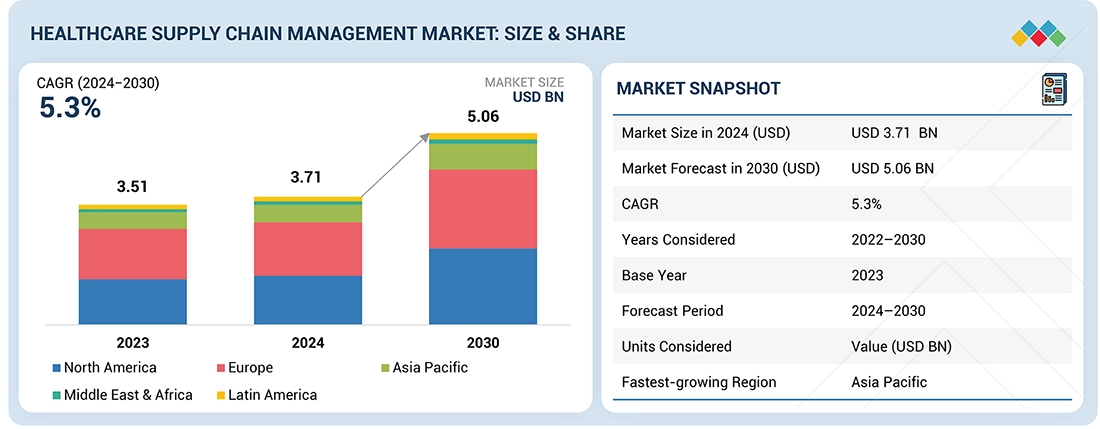
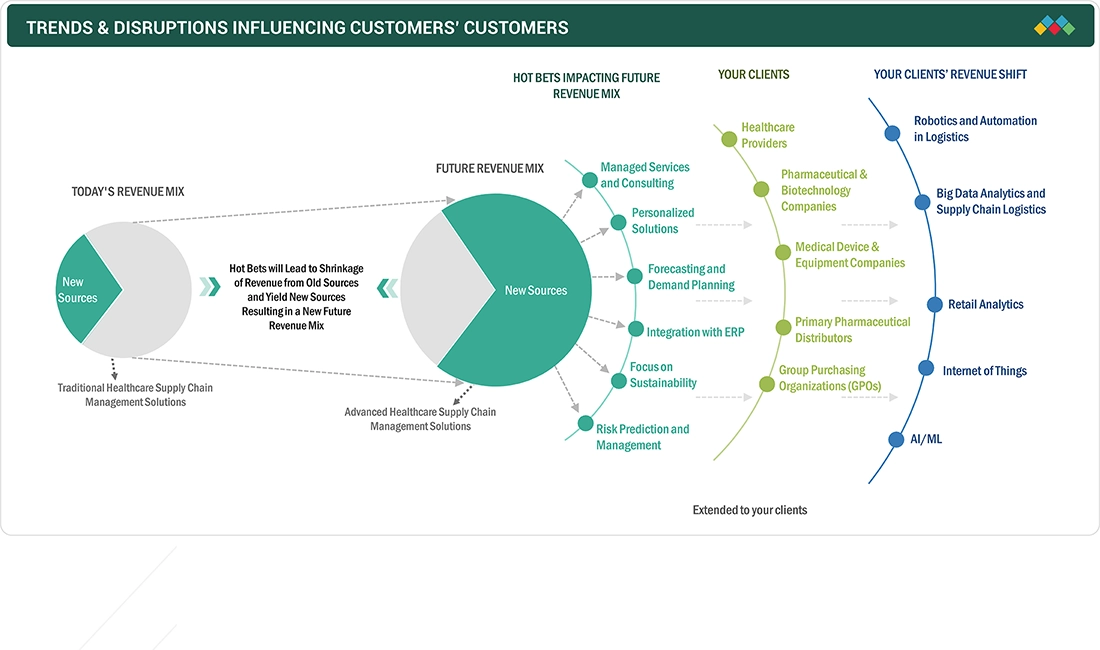






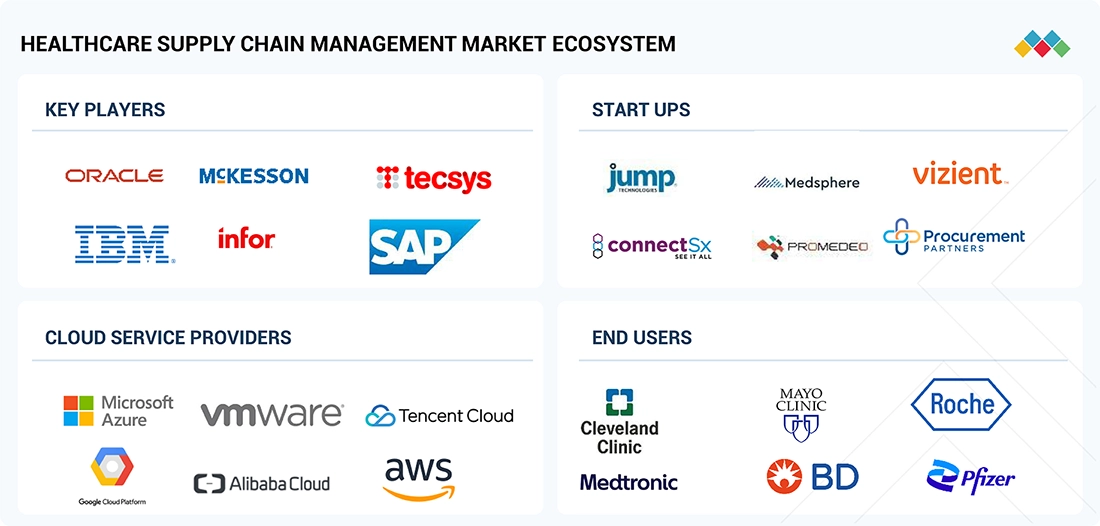

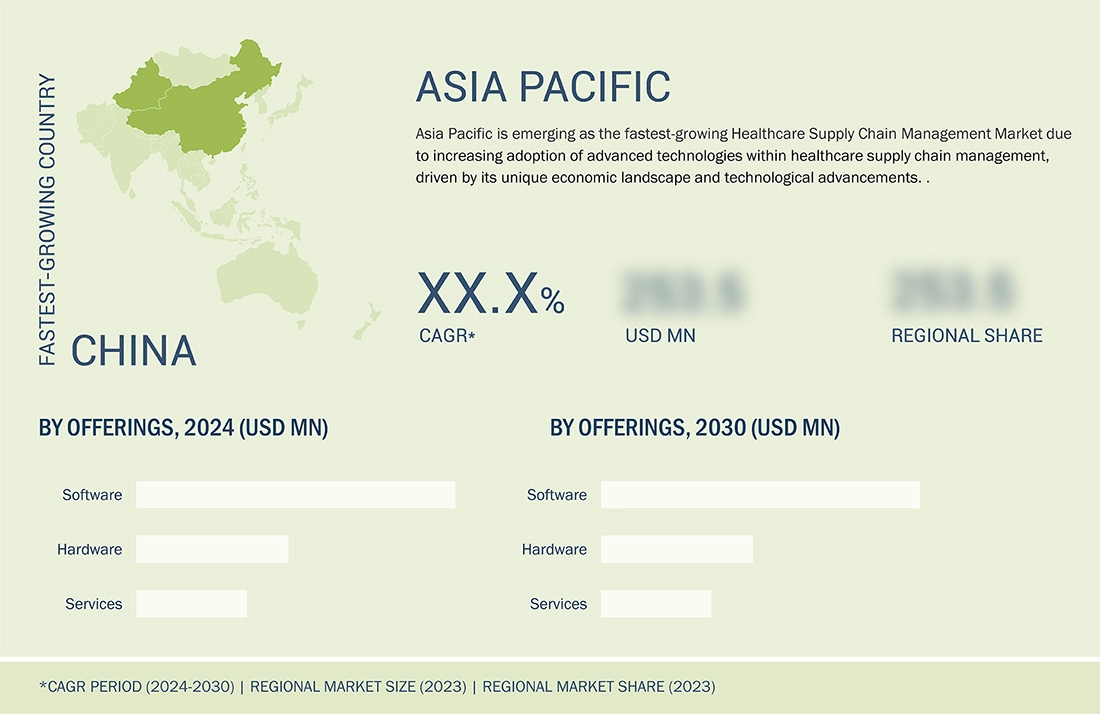
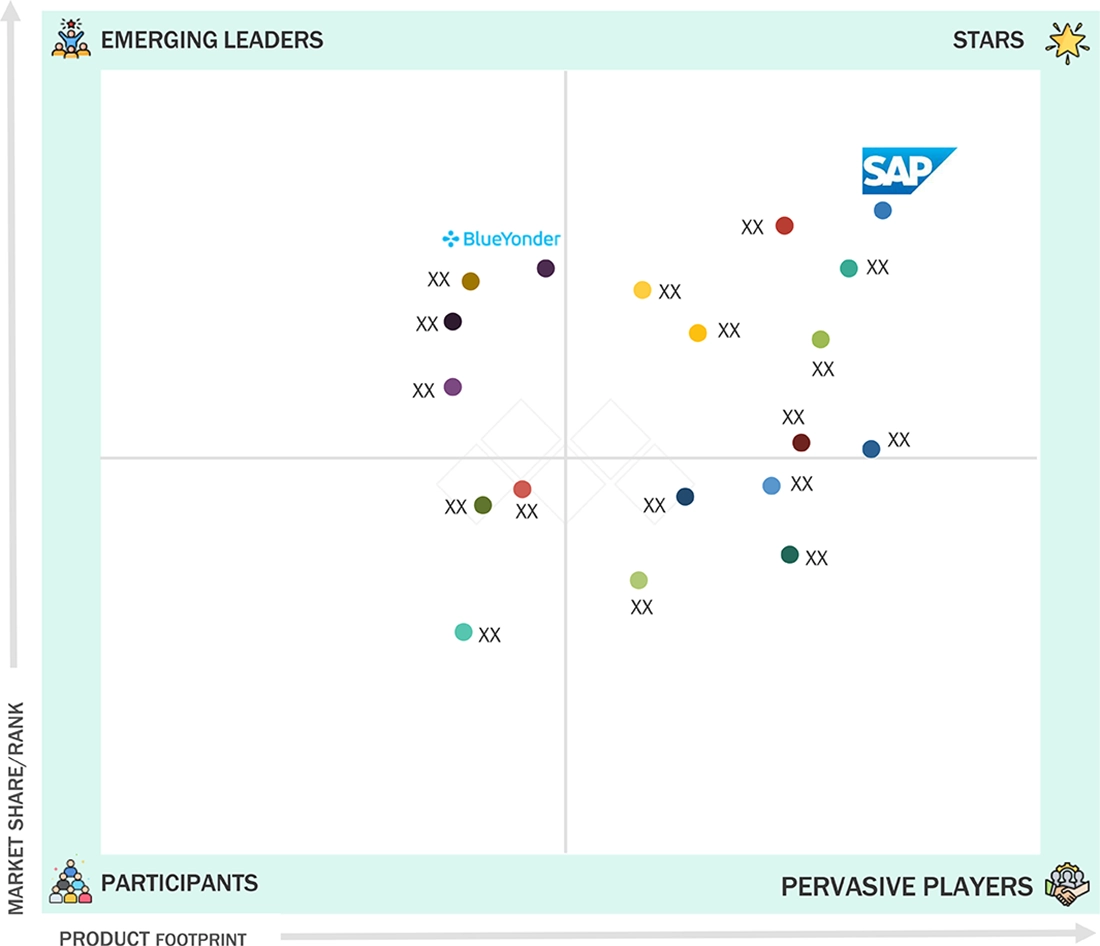
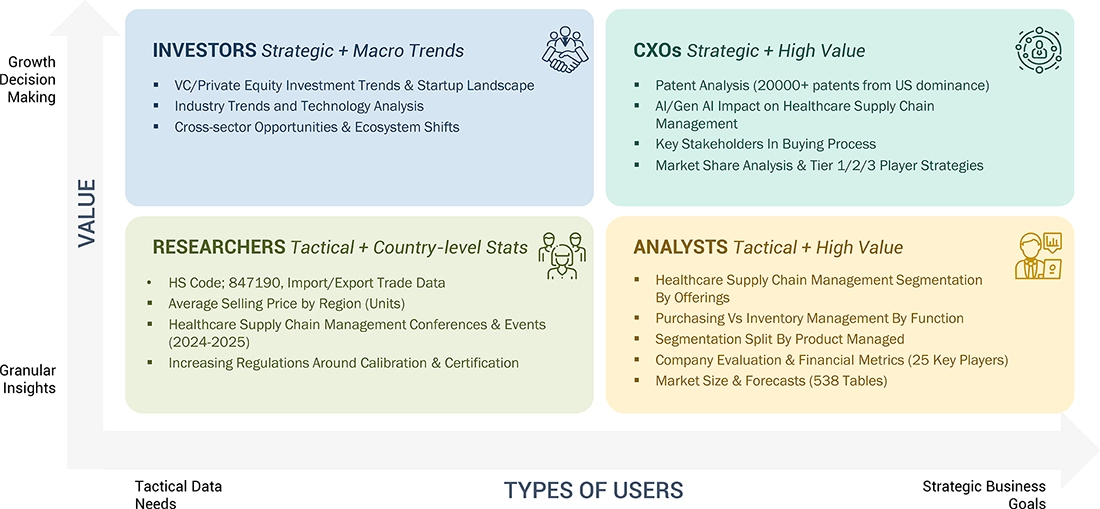

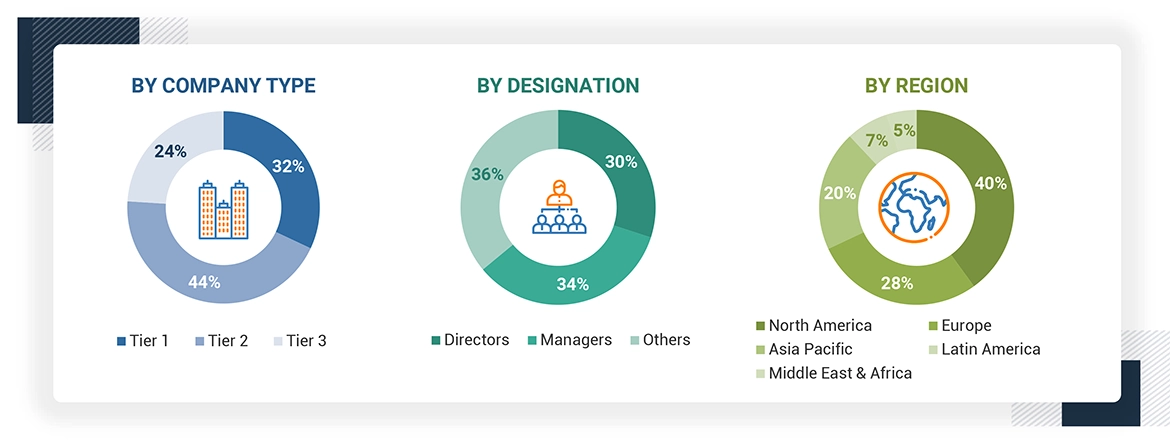
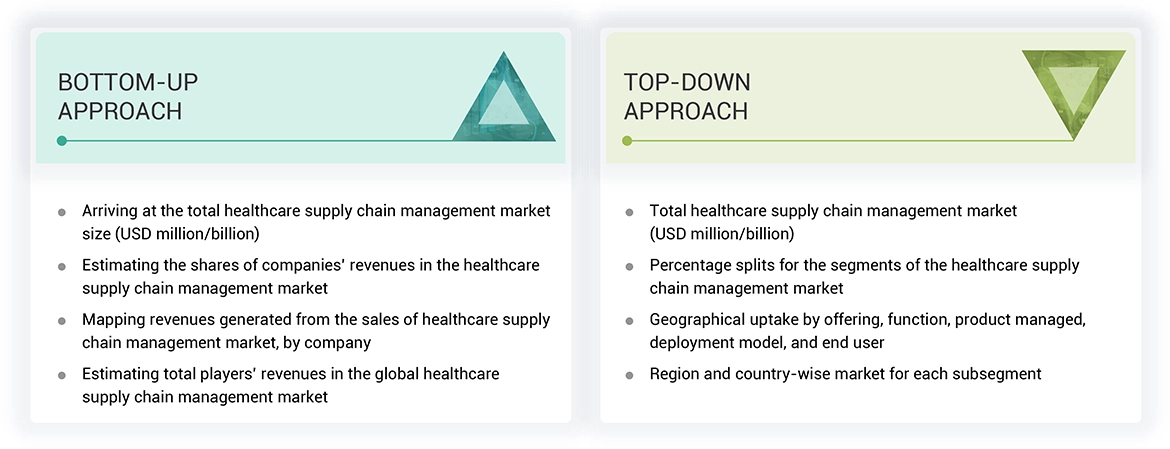













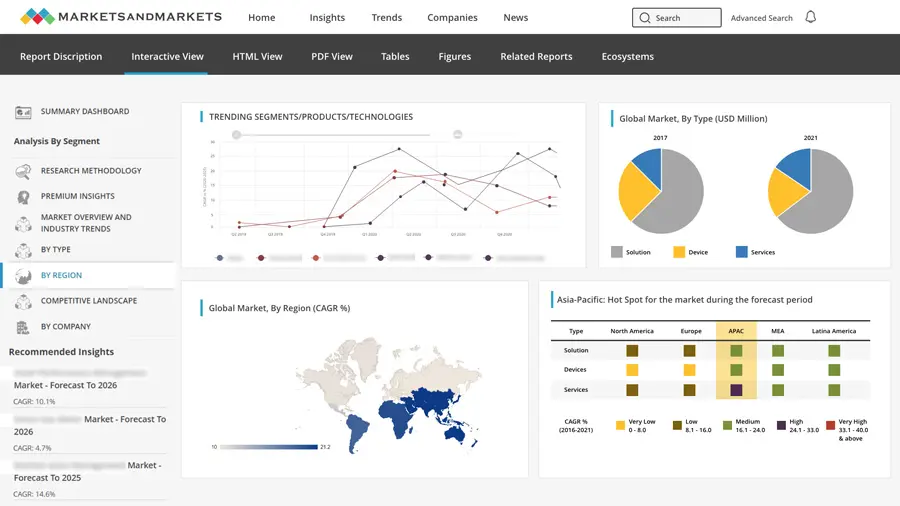
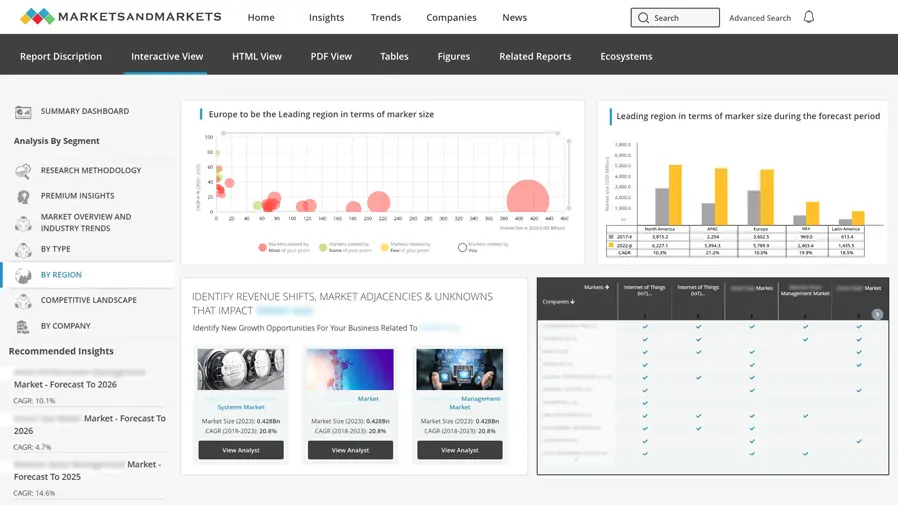
Growth opportunities and latent adjacency in Healthcare Supply Chain Management Market